

The Sea of Galilee: A Comprehensive Guide to Its Significance, History, and Natural Beauty
- May 10, 2023
A visit to Israel and the Sea of Galilee is not only a walk through time and religious history, but also a soothing respite to relax on a sandy beach, unwind with a leisurely scenic drive around the lake, or hike or bike the trails and absorb the beautiful scenery encompassing the area.
Visiting the many locations is an opportunity to experience the Sea of Galilee’s history, along with its culture, ancient ruins, and the beauty of the Holy Land on a personal level that creates memories to last a lifetime.
What is the Sea of Galilee History?
The Sea of Galilee’s strategic location along with its abundance of fish makes it a desired location for ancient civilizations, including the Romans, Hasmoneans, and Greeks. The lake resides on the Via Maris (aka Way of the Sea), which is an ancient trade route that linked northern empires, such as Anatolia, Syria, and Mesopotamia, with Egypt. The route dates to the Bronze Age. The dirt road served as a path along the coast to connect with other people living in the area and as a trade route for goods.
The sea, which is actually a lake fed by the Jordan River, had, at one time, the distinction of being the largest lake supplying drinking water to the country. It remains one of the earliest locations in Israel with pioneering settlements residing alongside archaeological ruins.
The closest city to the Sea of Galilee is Tiberias, located along the west edge of the lake. It is considered a holy city. It is believed the Talmud holy scriptures were written in Tiberias.
The Sea of Galilee remains an important resource for commercial fishing. The sea contains more than 20 species living in the lake’s waters. Ten of the species are important to commercial fishermen.
Today, the Sea of Galilee remains a pilgrimage site for Christians who travel from faraway places around the world.
Why is the Sea of Galilee significant in religious history?
Through the centuries, the Sea of Galilee has been known to be the site of many Christian religious events . Jesus of Nazareth grew up near the Sea of Galilee and ministered to the people of the area.
A visit to the Sea of Galilee sites puts tourists, as well as those on a personal pilgrimage, in the area where it is believed the Baptism of Jesus by John the Baptist is said to have taken place in the Jordan River, located at the southern tip of the Sea of Galilee. More than half a million people, including tourists, locals, and those on pilgrimage, visit the site each year. The site is known as Bethany Beyond the Jordan and is listed as a UNESCO World Heritage site.
The Sea of Galilee in the bible notes the hill known as the Mount of Beatitudes in Northern Israel is where it is believed Jesus delivered his Sermon on the Mount where the Lord’s Prayer was taught for the first time. The deep blue water of the sea is also where it is said Jesus walked on the water and calmed a raging storm that saved the 12 disciples with him onboard the boat.
Feeding of the 5000 , also referred to as the “miracle of the five loaves and two fish” is reported by the Gospel of John that the bread and fish were supplied by a local boy, and with these items, Jesus was able to feed the multitude. The location where the feeding of the 5,000 took place was somewhere along the Sea of Galilee’s northwestern shore in Tabgha or Hippos. The feeding of the 5,000, according to ancient fifth-century mosaics, both locations are mentioned. The event took place around 480 A.D.
Three large cities near the Sea of Galilee’s northern shore were cursed by Jesus because each city refused to repent. The cities were Bethsaida, Korazim, and Capernaum. Located within the Korazim National Park , visitors will see the preserved remains of an ancient Jewish village and synagogue. In Bethsaida, a variety of excavations have revealed structures dating to the 10th century, including ruins of a palace, houses, a temple, paved roads, and a Roman city wall. Capernaum is considered one of the most sacred f Christian pilgrimage sites in Israel with its many historical landmarks and archaeological excavations that include two ancient synagogues.
What Makes the Sea of Galilee a Natural Beauty?
Also known as Lake Kinneret, Lake Tiberias, Lake of Gennesaret, Sea of Tiberias, and Lake Galilee, not only is the area a popular religious destination for travelers from around the world but it is also known for its extraordinary natural beauty.
A perfect picture postcard showing an expanse of brilliant deep blue water bordered by towering mountains and an inviting shoreline of hills with lush greenery and tall palm trees is a good way to describe the atmosphere and environment awaiting travelers to the Sea of Galilee.
The sea, itself, makes a visual statement with its impressive dimensions. It has a length of 12 miles, a width of close to eight miles, and a depth of 200 feet.
The sea rests serenely in northern Israel, enhanced by the towering peaks of Mount Arbel to the west, the Lower Galilee hills to the southwest and the multiple cliffs to the east of the Golan Heights as they stretch towards the shoreline.
Depending on the season, the Sea of Galilee is a contrast of colors, with spring being the most colorful time of year when the hills and slopes are like a vibrant green carpet covering the landscape. Winters are mild and summer is hot, which makes the area ideal for agriculture with farms producing assorted items, such as barley, grapes, olives, figs, bananas, alfalfa, and wheat.
Scattered throughout the hillside are quaint homes, ancient ruins, beautifully detailed and historic churches, as well as modern structures.
In Tiberias, ancient hot springs over 3,000 years old add to the tranquility and natural beauty of the Sea of Galilee. Visitors can refresh and replenish in the soothing natural thermal waters of the springs.
From the hillsides to the shoreline, wherever you look, the views are breathtaking, from the scenic mountains to the sun setting on the horizon casting warm hues across the Sea of Galilee.
Where to stay at the Sea of Galilee?
Tiberias is the closest city to the Sea of Galilee, a little less than 4 miles away. The choice of accommodation is plentiful, with over 100 hotels to choose from, ranging in prices from quality inexpensive hotels and upgraded mid-range boutique accommodations to high-end luxury resort-style hotels. Guests staying at area hotels can expect amenities, such as outdoor swimming pools, spas, onsite dining, room service, bars, fitness center, hot tub, free breakfast, full-service laundry, smoke-free properties, non-smoking rooms, free parking, kid-friendly accommodations, and airport shuttle service.
For travelers who prefer a more private and less crowded setting, Airbnb vacation rentals are also available in Tiberias. A variety of homes and prices are available, such as an ancient, restored stone house, a ground-floor apartment with unobstructed views of the Sea of Galilee, a luxurious apartment with a private terrace, or a lavish beachfront house. These accommodations feature the comforts of home. Some have additional features, such as a heated swimming pool, private garden, outdoor gazebo, barbecue area, fully accessorized kitchens, cable TV, and Wi-Fi.
There are also several bed and breakfasts available in Tiberias for those who want a comfortable setting with no crowds, but also provide an array of features and amenities. A few of the features guests can expect include swimming pools, free Wi-Fi, air conditioning, full-screen TV, kitchenettes, and airport shuttle service.
What can you do at the Sea of Galilee?
There is a variety of Sea of Galilee activities to suit all ages and individual interests, from historical landmarks to national parks.
The Sea of Galilee location is in northern Israel and is the largest freshwater lake in Israel, measuring 13 miles from north to south. Explore the lake and surrounding area by car or take one of the many tours to experience the many wonders of this holy destination.
Consider including these things to do and see on your travel itinerary:
- Hamat Tiberias National Park (Tiberias).
- Kursi National Park (archaeological site on the eastern shore of the Sea of Galilee).
- Capernaum (ancient pilgrimage site on the northern shore of the Sea of Galilee).
- Yardenit (southern region of the Sea of Galilee).
- Mount of Beatitudes.
- Tomb of Maimonides (in Tiberias).
- Kinneret Trail (walk or bike around the trail, which encircles the Sea of Galilee).
- Hike the Jesus Trail from Nazareth to Capernaum.
- Go canoeing on the lake.
- Take a lake tour.
- Kfar Blum rafting (Jordan River)
- Visit Switzerland Park for scenic views.
- Ros Hanikra Grottoes.
- Relax at one of the beaches surrounding the Sea of Galilee. (no facilities).
- Mount Arbel (near Tiberias offers hiking trails, ancient ruins, water views, and caves).
- Scots Church.
- Church of the Multiplication of the Loaves and Fish (Tabgna).
- Bible Lands Museum (archaeological museum in Jerusalem)
- Yigal Alon Center (Ginosar, on the western shore of the Sea of Galilee housing the ancient boat).
What is the best time to visit the Sea of Galilee?
Travelers who want to experience the Sea of Galilee and all there is to do and see when the weather is at its best is from March through October, when temperatures average 91 degrees Fahrenheit (32.77 Celsius).
For sun lovers, August is the hottest month when temperatures average around 97 degrees Fahrenheit (36.1 Celsius).
Cooler temperatures prevail from December to March, with daily highs averaging around 71 degrees Fahrenheit (21.66 Celsius). If cold weather is your personal preference, set your itinerary for January, when the high temperature averages 64 degrees Fahrenheit (17.77 Celsius) to an average low of 47 degrees Fahrenheit (8.33 Celsius).
How do I get there?
The main airport that serves cities, including Jerusalem, Tel Aviv, and Haifa, is Ben Gurion International Airport. From the airport, a shuttle bus service to Jerusalem is available 24 hours a day. From the central station, the bus departs from Jerusalem to Tiberias, which is about 93 miles (150km) away and located along the edge of the Sea of Galilee. The trip can take anywhere from 2-3 hours, depending on the route the bus takes.
A rental car is also an option. Use the car rental kiosk at the airport, which has most major car rental companies, or, once arriving in Jerusalem, visit one of the car rental locations. Note that some car rental companies have specific rules for renting a car that include Shabbat.
There is also the option of traveling by train from Tel Aviv to Tiberias, which takes approximately 1.5 hours. Travelers can also take a bus, which is inexpensive and takes about 2 hours, or, if driving is preferred, the drive time between Tel Aviv and Tiberias is about two hours.
Table of Contents
Book your trip, explore more about israel.

Things to Do in Tel Aviv: Visiting the Old Jaffa Flea Market and Port

Understanding the Significance of the Western Wall Prayer Request

10 Amazing Restaurants Near Tel Aviv Beach
Privacy overview.
Must-see attractions in Sea of Galilee
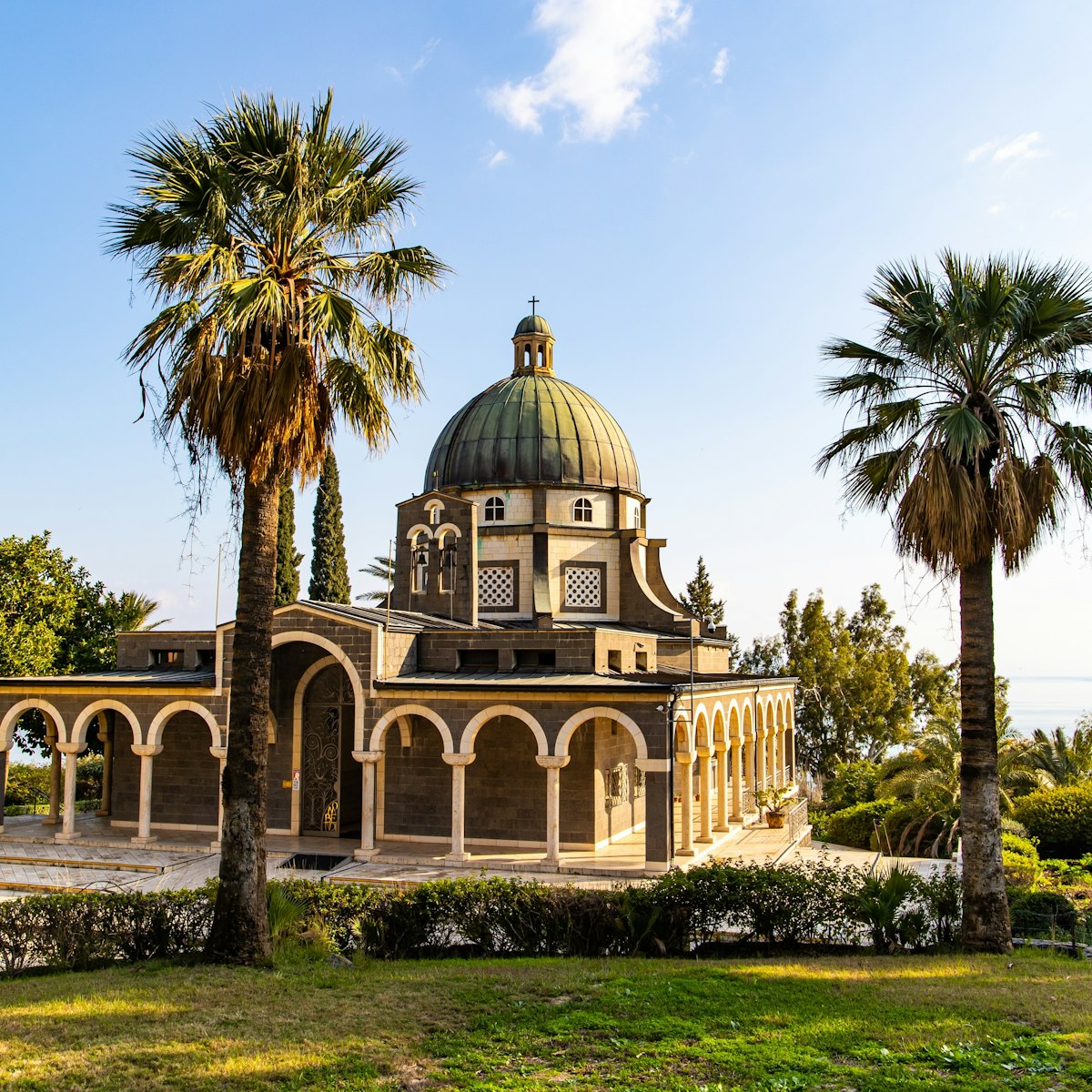
Mount of the Beatitudes
Sea of Galilee
Since at least the 4th century, this landscaped hillside is believed to be where Jesus delivered his Sermon on the Mount (Matthew 5–7), whose opening…
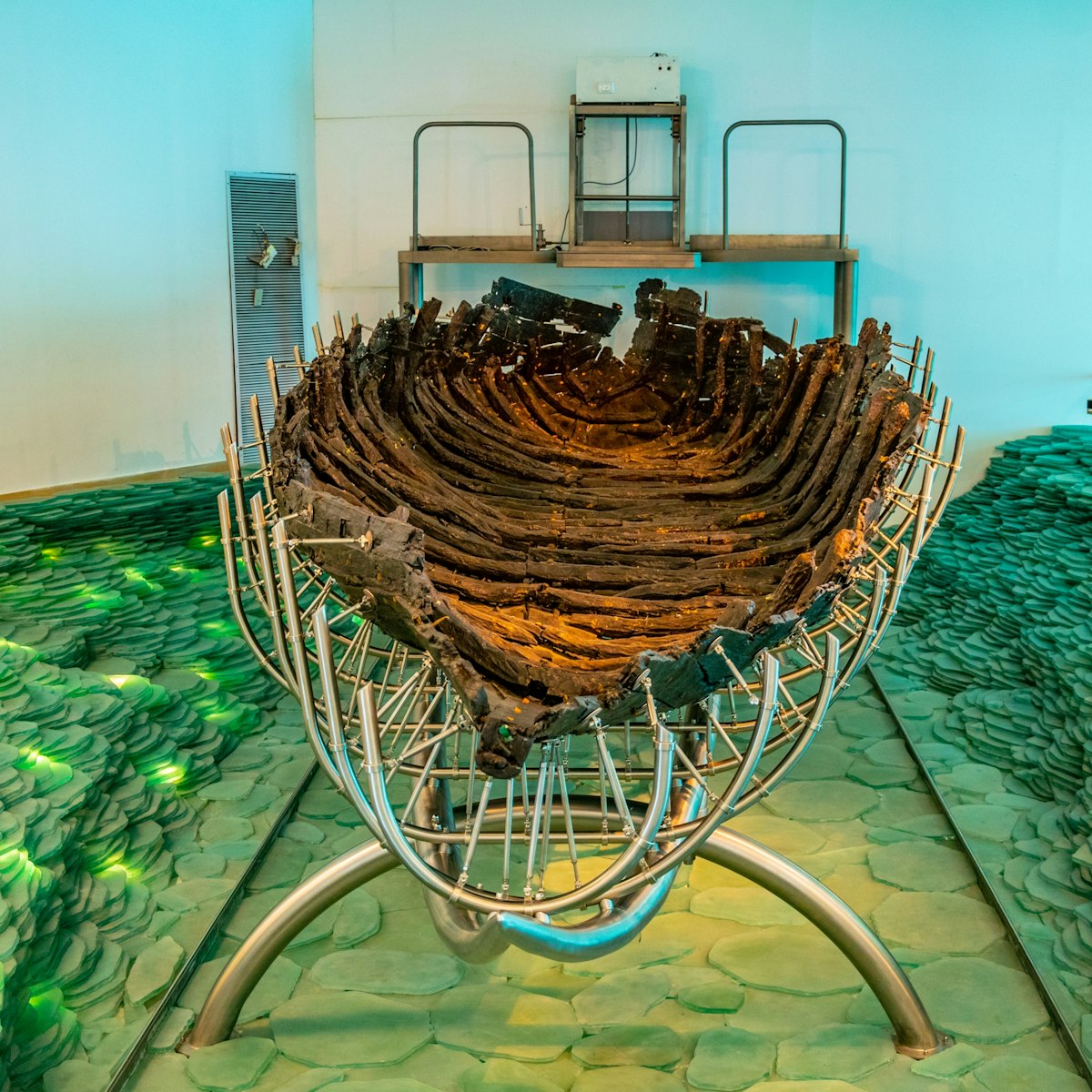
Ancient Galilee Boat
In 1986, when the level of the Sea of Galilee was particularly low, a local fisherman made an extraordinary discovery: the remains of a wooden boat later…
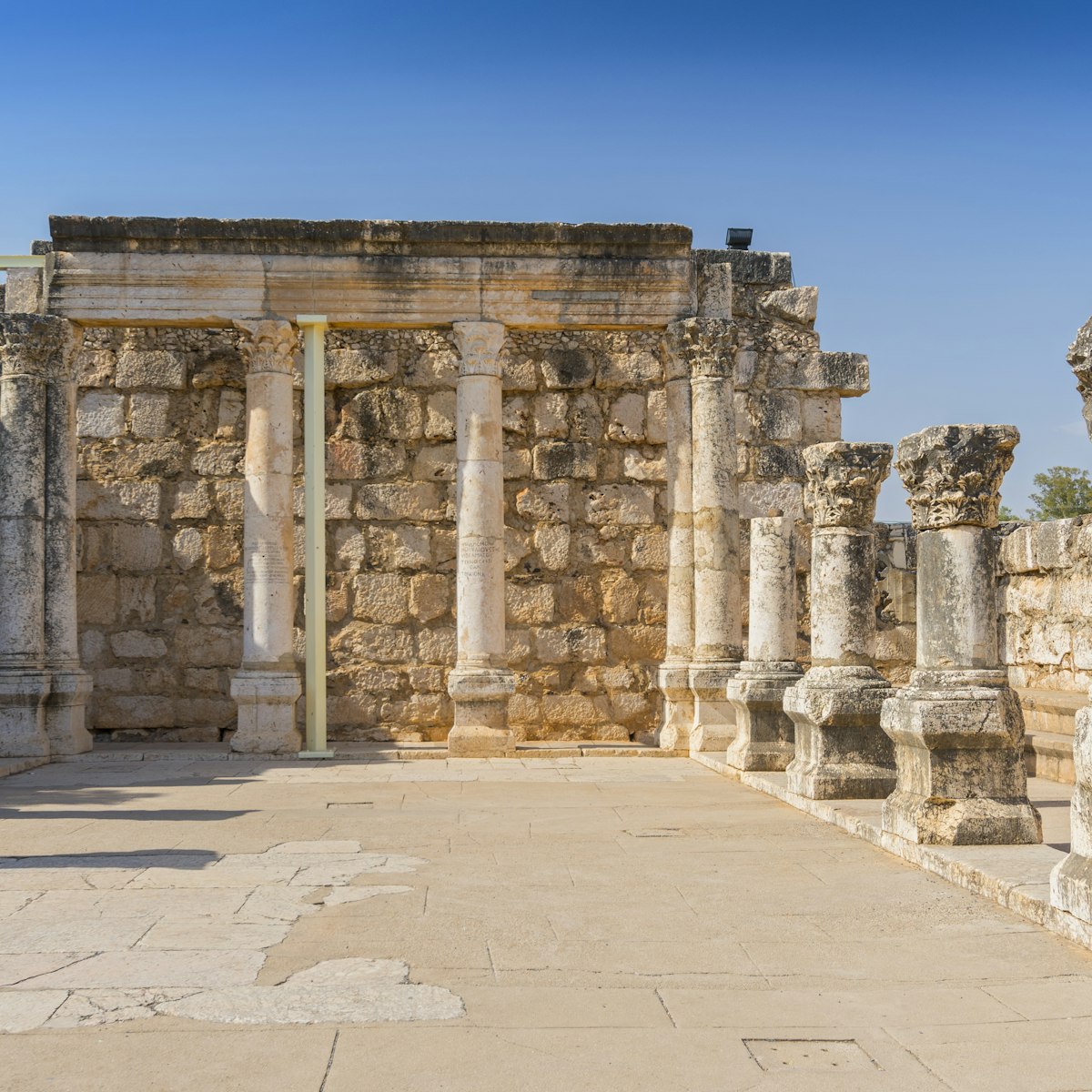
The New Testament says that the prosperous lakeside village of Capernaum (estimated population 1500), on the imperial highway from Tiberias to Damascus,…
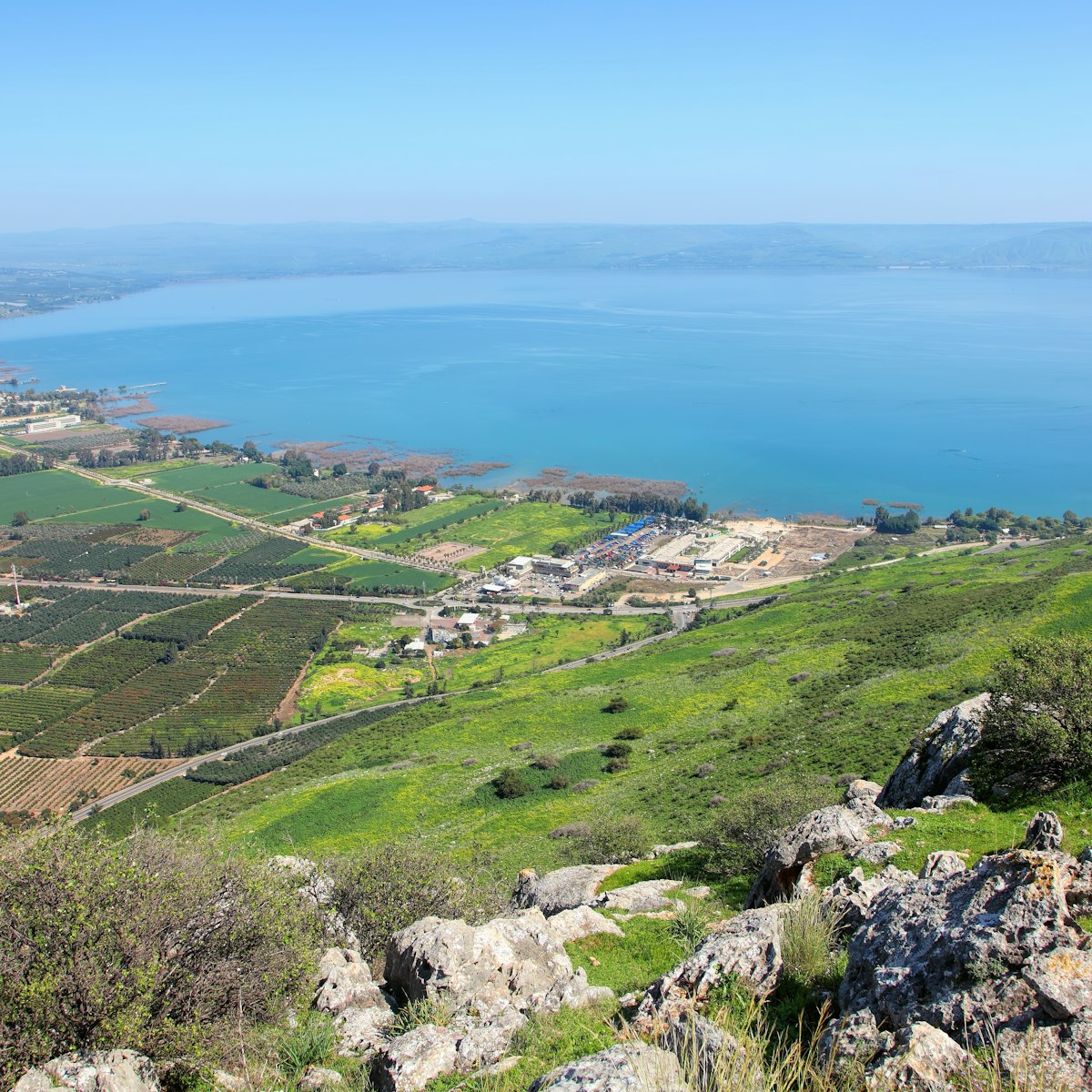
Arbel National Park
Towering over the Sea of Galilee and offering breathtaking views of the Golan Heights and Mt Hermon, Arbel Cliff is 181m above sea level, which makes it…
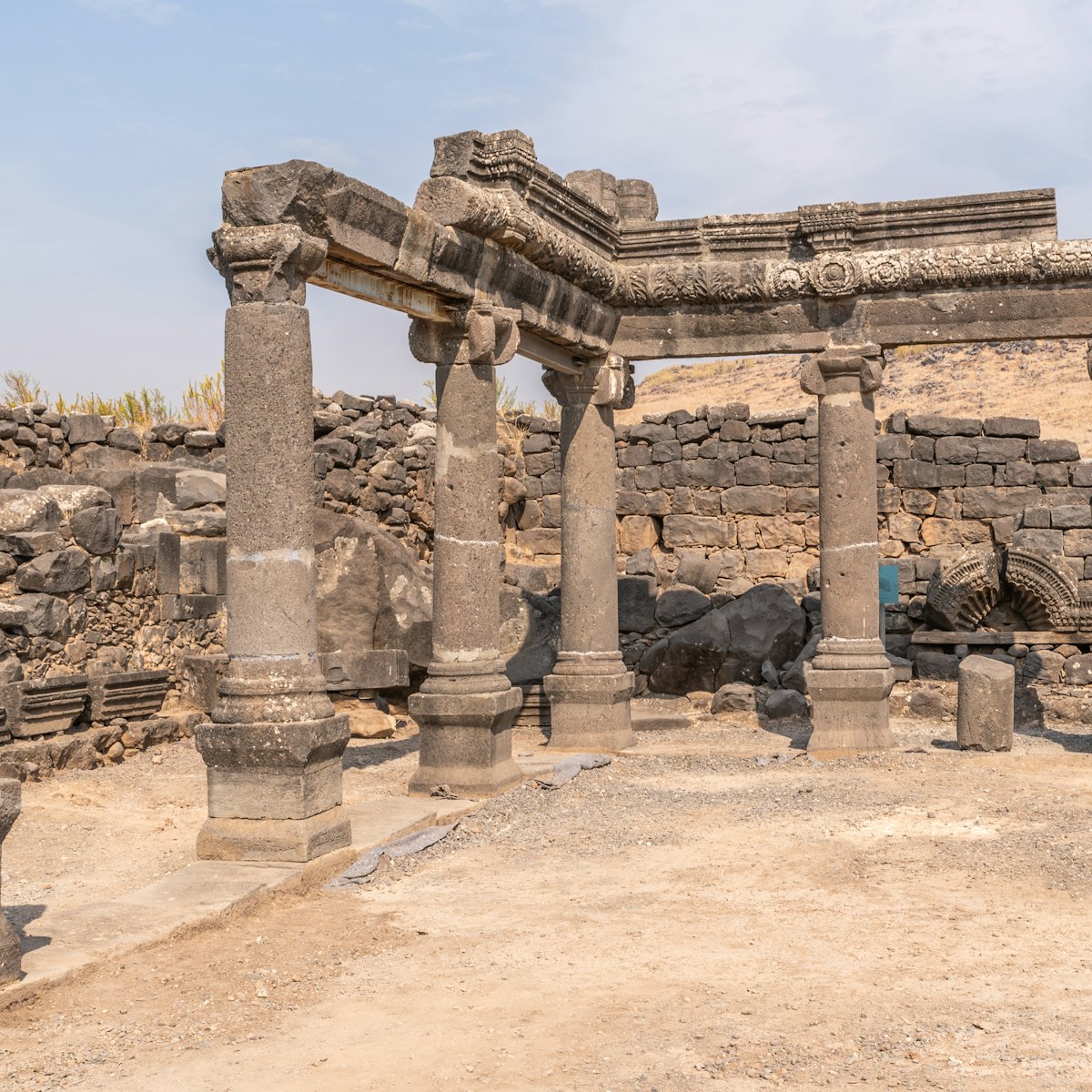
Korazim National Park
On a hillside overlooking the Sea of Galilee, Korazim is a good place to get an idea of the layout of a prosperous, midsized Galilean town in the time of…
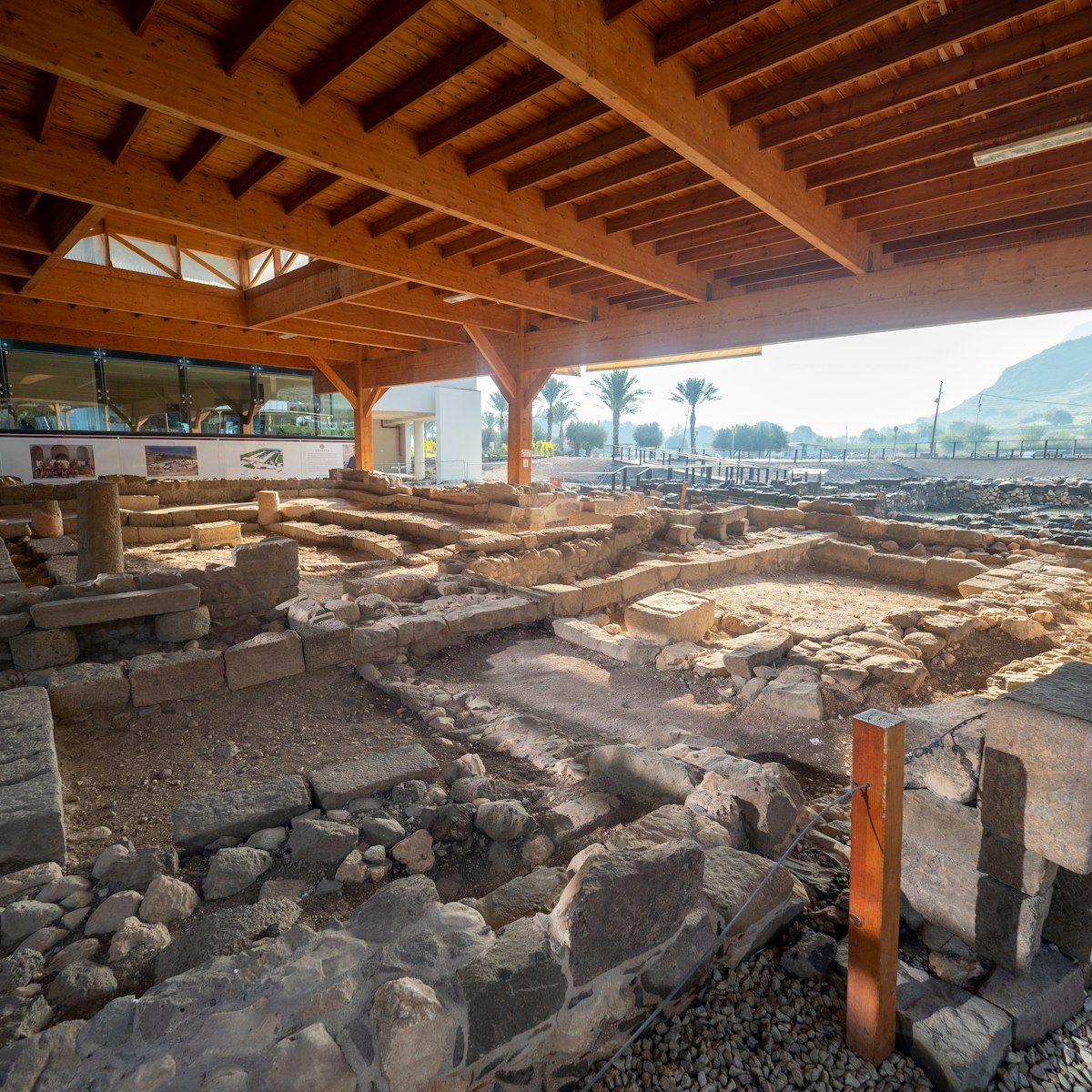
When the Legionnaires of Christ, a Catholic congregation based in Mexico, began building a spiritual retreat in 2009, they were astonished to discover a…
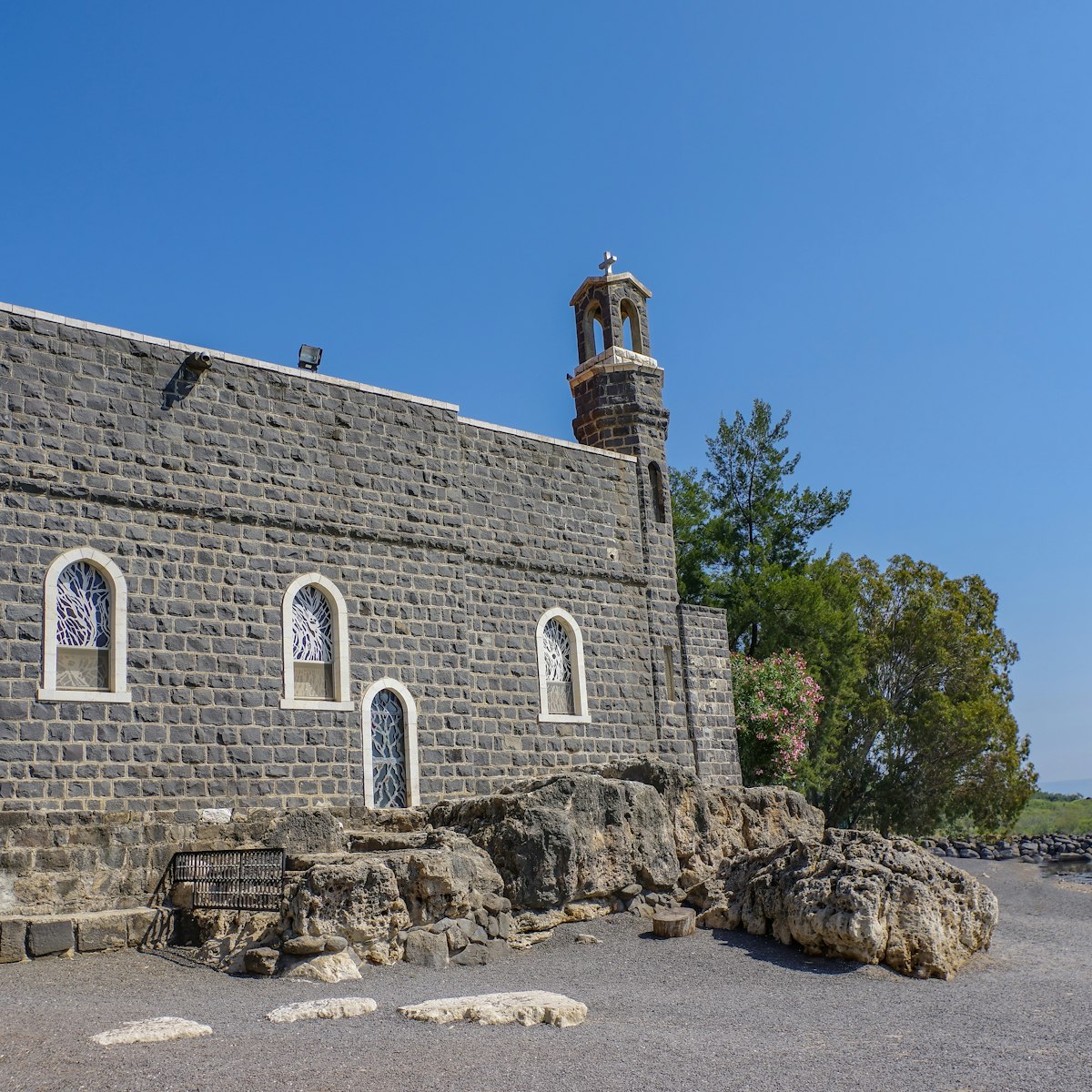
Church of the Primacy of St Peter
A shady, fragrant garden leads down to the lakeshore and to this Franciscan chapel (built 1933), lit by the vivid colours of abstract stained glass. The…
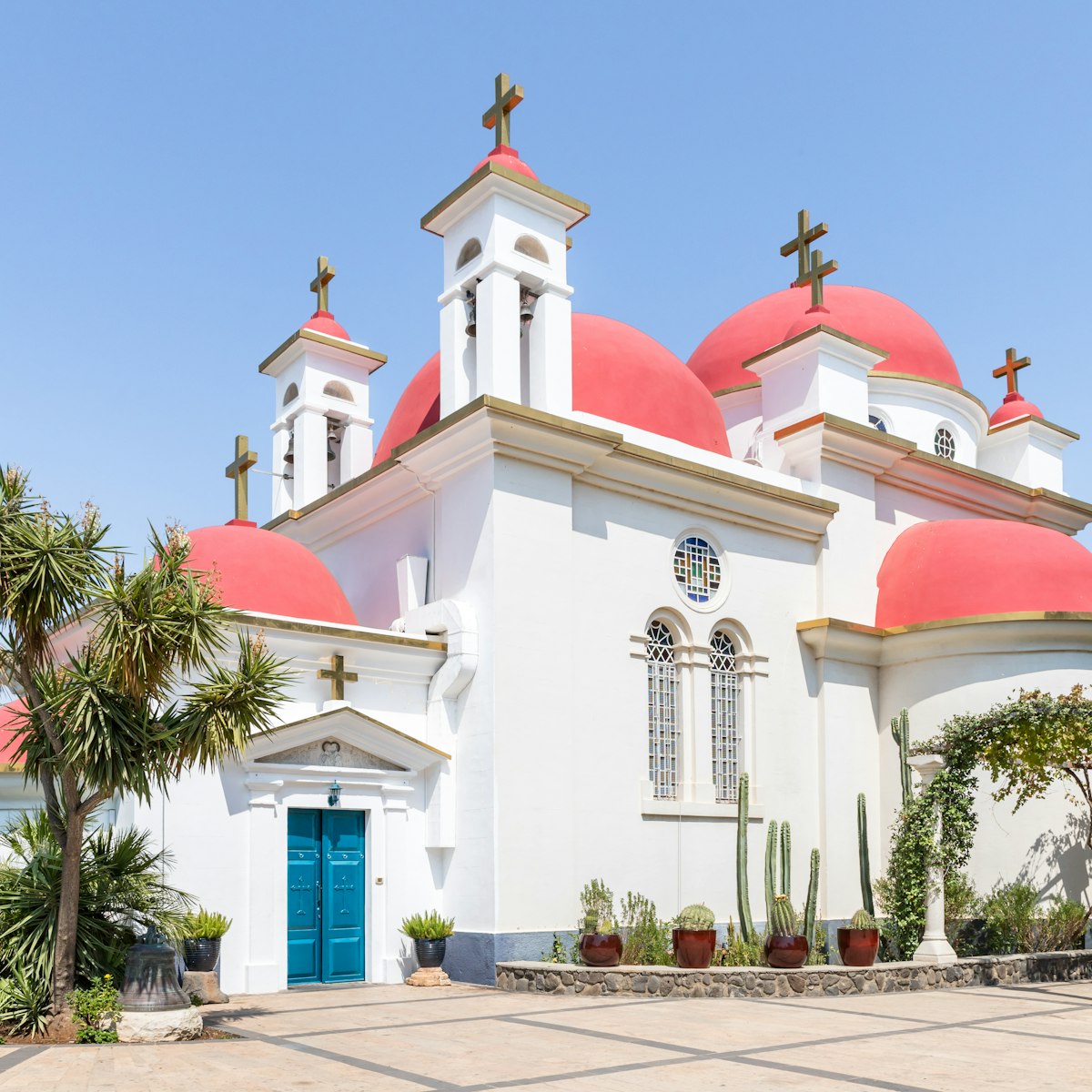
Monastery of the Twelve Apostles
Peacocks strut around the serene, deeply shaded lakefront garden of this Greek Orthodox site, 200m as the crow flies (1.6km on foot or by car) northeast…

Kinneret Cemetery
Shaded and serene, this luxuriantly leafy lakeside cemetery, established in 1911, is the final resting place of socialist Zionist pioneers such as Berl…
Bet Gabriel
Opened in 1993, this lakeside cultural centre – one of Israel’s most beautiful buildings – is known for its art exhibitions, first-run cinema (two screens…
Yardenit Baptismal Site
This hugely popular, eucalyptus-shaded baptism site, run by Kibbutz Kinneret, is on the Jordan River 100m south of where it flows out of the Sea of…
Kursi National Park
Mentioned in the Talmud as a place of idol worship, this Gentile fishing village – discovered by chance in the early 1970s – is where Jesus is believed to…
Majrase Nature Reserve
Located in the northeastern corner of the Sea of Galilee, the spring-fed streams and jungle-like wetlands of this reserve are ideal for a refreshing …
Church of the Multiplication of the Loaves & Fishes
This austere German Benedictine church was constructed in 1982 on the foundations of a 5th-century Byzantine church. The rock under the altar is believed…
Domus Galilaeae
Near the summit of the Mount of the Beatitudes, this exquisite modern complex serves as a venue in which Christians – especially Catholic seminarians –…
The ruins here, inside HaYarden Park Nature Reserve (Jordan River Park), are believed to be those of the ancient fishing village of Bethsaida, where Jesus…
More destinations you need to see


Exploring the Galilee Region: A Traveler’s Guide to Northern Israel
The Galilee region is a picturesque and culturally rich destination in Northern Israel that offers a unique blend of history, natural beauty, and biblical sites. Whether you’re a history enthusiast, a nature lover, or seeking a tranquil getaway, the Galilee has something to offer every traveler.
Northern Israel doesn’t make it into all Israel travel itineraries simply because people often don’t have time. But if you have a week or more in Israel, it is not to be missed. This region is also an essential stop on tours in Nazareth and package tours that cover top Israel destinations. If you are short on time, organized tours can be the solution, there are Galilee tours of various lengths that leave from central Israel.
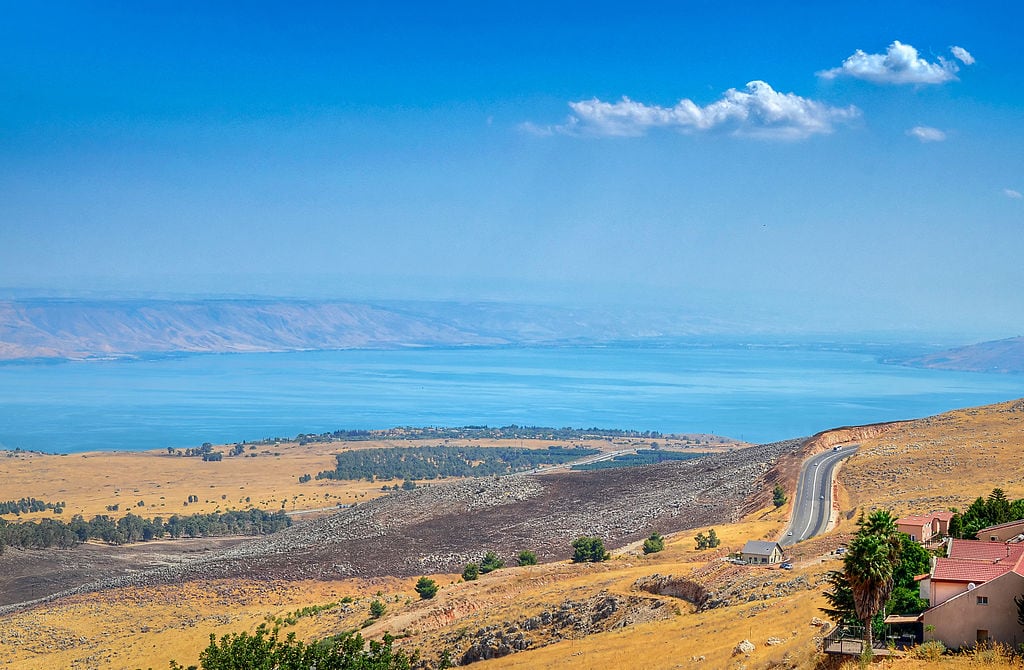
Who Should Visit Galilee?
Anyone visiting Israel who has the time should visit Galilee. It will show you a completely different side of Israel from the bustling cities like Tel Aviv, and Jerusalem or the barren deserts of the south. This region’s beauty is a stark contrast to the arid landscapes found in other parts of Israel, making it a refreshing destination for those seeking a greener escape. Here you’ll see the farmlands, small villages, and lush landscapes, with rolling hills, serene lakes, and forests.
Getting to the Galilee
Israel is a small country and reaching Galilee is not a problem, even if you are using public transport. If you’ve rented a car it is a pleasant two-hour (137 km) drive to Galilee from Tel Aviv. Public buses take only slightly longer to get from central Israel to Tiberias on the shore of the Sea of Galilee. Another option is to take a train from Tel Aviv to Haifa and from there continue by bus.
The Best Time to Visit Galilee
Northern Israel can be visited at any time of year. June to September can be extremely hot and the months of December to February can be cold and wet, but Israel’s weather is mild compared to European and American standards. Apart from the weather you need to take into consideration Shabbat, and public holidays when some businesses, attractions, and public transport shut down.
Where to Base Yourself on a Trip to Galilee
If you are only staying for a day or two, base yourself in Tiberias or one of the smaller communities on the edge of the Sea of Galilee. If you have the opportunity to travel to several Galilee destinations then include a stay in Acre, Nazareth, Tiberias, and Safed.
Top Destinations in Galilee
Nazareth: where history and spirituality unite.
Begin your Galilee adventure in Nazareth, the childhood home of Jesus and a city steeped in religious significance. The Basilica of the Annunciation is the city’s top attraction and commemorates the announcement of the Angel Gabriel to the Virgin Mary. Other stops in Nazareth include St Joseph’s Church and Mary’s Well. As you wander through the Nazareth market you’ll be enveloped in the rich tapestry of Arab culture, tantalizing your senses with aromas and flavors unique to this region.
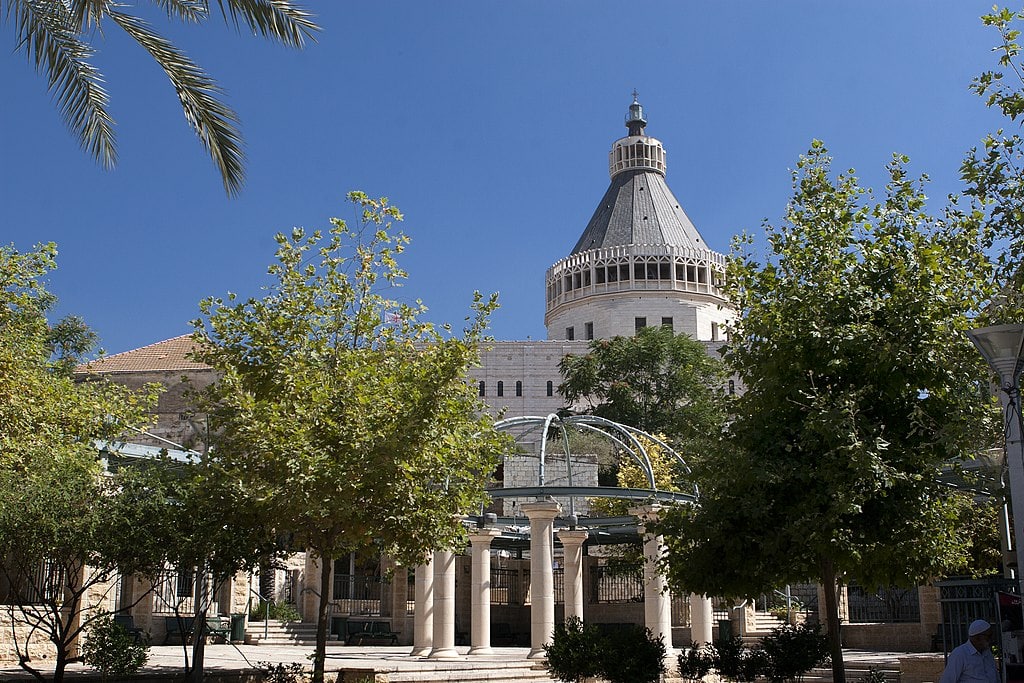
Sea of Galilee: The Cradle of Christianity
The Sea of Galilee, also known as Lake Kinneret, is the largest freshwater lake in Israel and the setting for many biblical events. Visit the Mount of Beatitudes, Tabgha, and Capernaum, where the ruins of an ancient synagogue stand as a testament to the area’s historical and spiritual significance. The largest city on the shore of the Kinneret is Tiberias where you’ll find modern facilities, natural hot springs, and beaches.
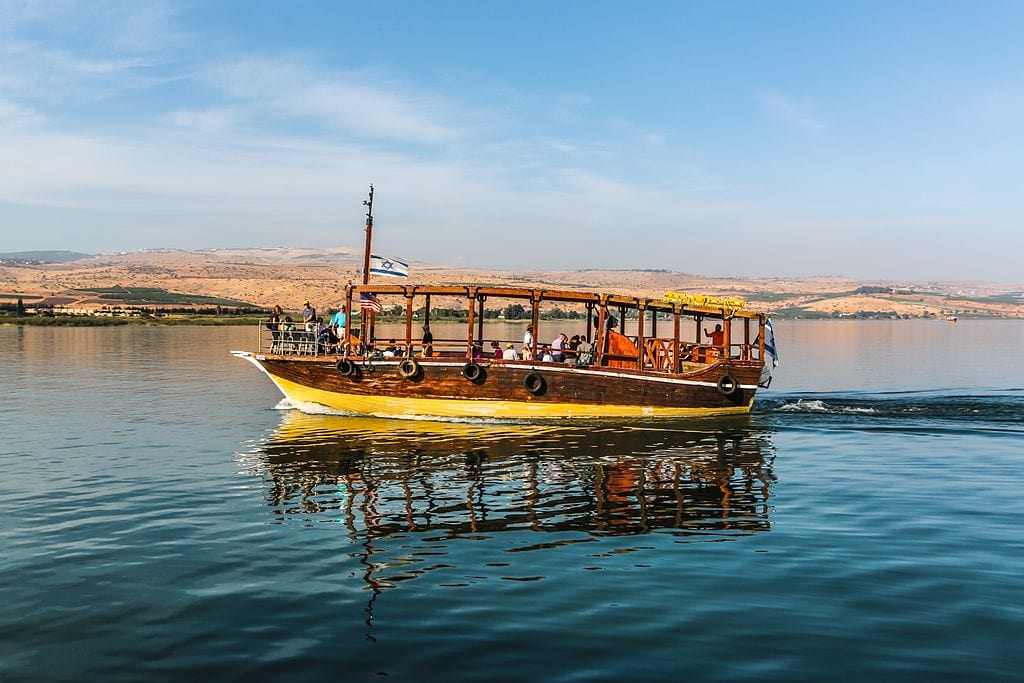
Safed (Tzfat): HIlltop Home to Jewish Mysticism
Known as the center of Jewish mysticism or Kabbalah, Safed is a city where creativity and spirituality intertwine. The city is famous for its blue-domed synagogues, art galleries, and vibrant artist community. Stroll through the cobblestone streets, admire the colorful artwork, and experience the spiritual atmosphere that pervades the city.
Acre: Ancient Crusader City
Acre, also known as Akko, is a coastal city that brims with history and offers visitors a captivating blend of cultures. This UNESCO World Heritage Site is famous for its well-preserved medieval architecture and enchanting old town. Explore the labyrinthine alleys of the old city, see the remains of an underground Crusader city, and wander through the city’s vibrant bazaar. Acre’s seaside promenade invites you to savor fresh seafood and take a boat ride from the old port.
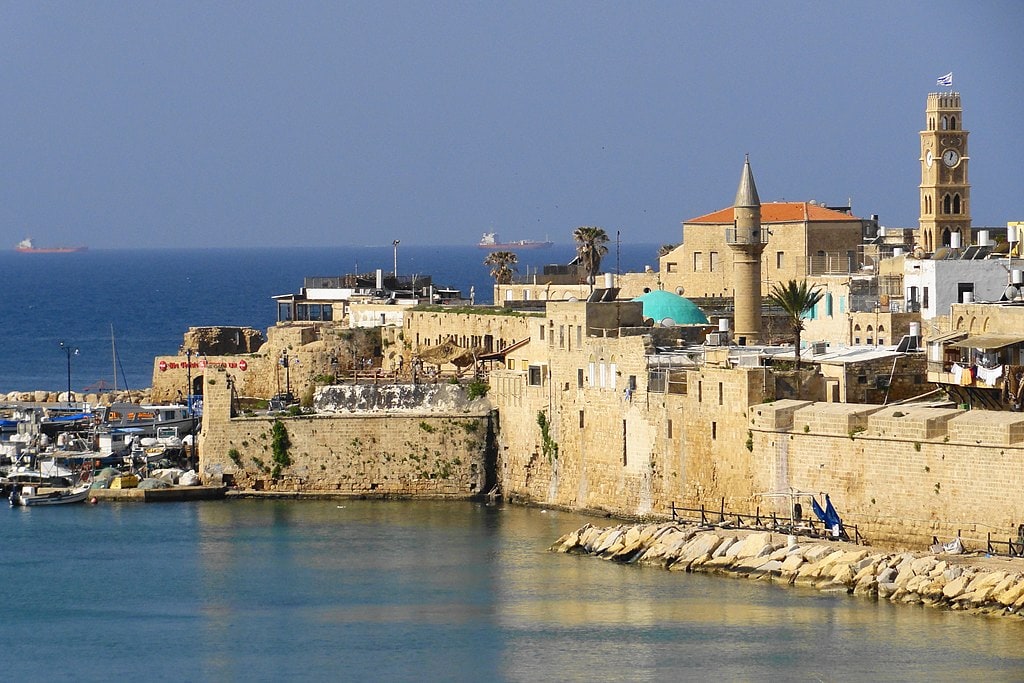
Rosh Hanikra: Natural Sea Caves
Rosh Hanikra, located on the border with Lebanon, is a stunning geological formation where white cliffs meet the waters of the Mediterranean. Reach the Rosh Hanikra grottoes via a short cable car ride, and see how waves have carved out a labyrinth of caves over thousands of years. Explore the caves, tunnels, and walkways that allow you to get up close to this breathtaking natural wonder.
Top Galilee Experiences
● gourmet experiences.
Foodies will delight in Galilee’s culinary scene which thrives on the use of farm-to-table local produce, artisan foods, and fresh fish from the Kinneret. The region is also home to boutique wineries, so be sure to indulge in some wine tasting.
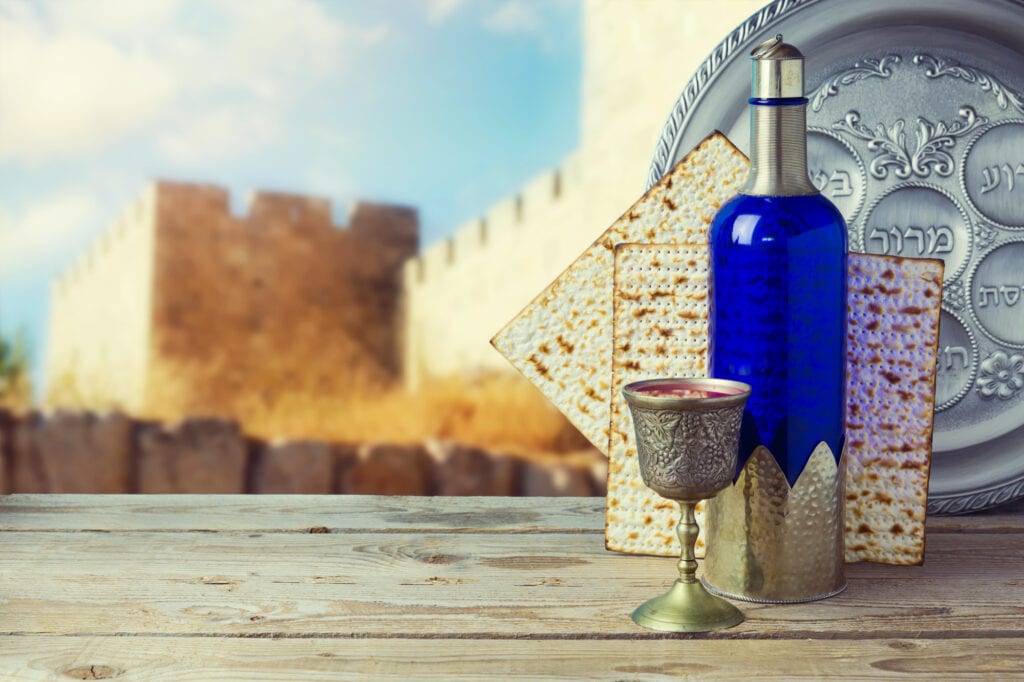
● Breathtaking Nature Reserves
The Galilee region boasts a variety of nature reserves and national parks. One highlight is the Hula Valley, a major stopover for migratory birds. If you’re looking for a hike, consider exploring the Galilee Panhandle National Park, which provides spectacular views of the surrounding landscape.
● Outdoor Activities
With its wide open spaces and spectacular scenery, Galilee is perfect for outdoor activities from hiking and biking to exploring archaeological sites. The Golan Heights overlooks the Sea of Galilee and on its highest peak, Mount Hermon you’ll find Israel’s only ski resort (open only in the winter months). Don’t miss watersports and boat trips on the Sea of Galilee.
● Baptismal Site – Yardenit
Christians can visit Yardenit at the southern end of the Sea of Galilee. Here it is possible to be baptized in the Jordan River as Jesus was.
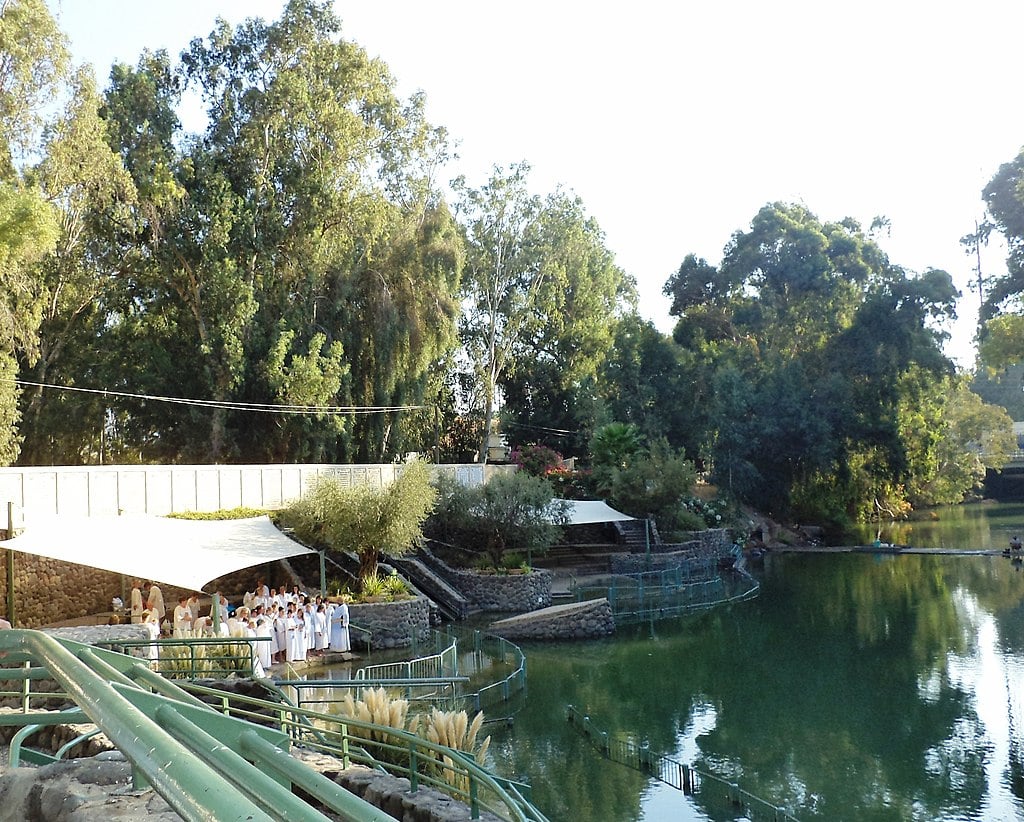
● Meet People from Diverse Minority cultures
Galilee is home to several minority communities, including the Circassians and Druze. The Circassian village of Kfar Kama offers a unique cultural experience with its traditional arts and crafts and culinary delights. Similarly, Daliat el Carmel is a Druze village that provides an opportunity to explore Druze culture and enjoy authentic Druze cuisine. These communities warmly welcome visitors, providing insights into their traditions, values, and history.
Visit Galilee
The Galilee region of northern Israel offers an enriching travel experience, blending history, spirituality, and natural beauty into a unique package. It’s a destination that can be enjoyed by travelers with a wide range of interests so pack your bags and embark on a journey to explore Galilee’s treasures and create unforgettable memories.
Faith was born in Ireland raised in Canada and has lived in over 10 countries in Europe including England, Ireland, Scotland, France, Spain, Northern Ireland, Wales, along with Mexico, Antigua, the US and has slow travelled to over 40 countries around the world. Graduating with a degree in Anthropology and Women's Studies Faith is a student of history, culture, community and food and has written about these topics for over 40 years.
View all posts

14 Top-Rated Tourist Attractions in the Sea of Galilee Region
Written by Jess Lee Updated Dec 24, 2023 We may earn a commission from affiliate links ( )
Forever entwined with the story of Jesus Christ, who carried out much of his ministry work in the area, the Sea of Galilee region is a beautiful place to visit, full of things to do and tourist attractions, from ancient archaeological remnants to drop-dead gorgeous scenery.
For Christians, of course, the best places to visit are the collection of churches around Tabgha, built over the sites where Jesus carried out his miracles. For other visitors, the placid lakeside scenery, hot pools, and hiking options in the surrounding hills provide enough reasons to spend some time here.
Find out what there is to do in the region with our list of the top tourist attractions in the Sea of Galilee Region.
See also: Where to Stay in the Sea of Galilee Region
1. Tiberias
2. hamat-tiberias hot springs, 3. bet yerah, 4. arbel national park, 5. kibbutz ginosar, 6. church of the multiplication of loaves and fishes, 7. church of the primacy of st. peter, 8. mount of beatitudes, 9. capernaum, 10. greek orthodox church of the 12 apostles, 11. bethsaida, 12. korazim, 13. yardenit, 14. degania, history of the sea of galilee region, where to stay in the sea of galilee region for sightseeing, map of tourist attractions in the sea of galilee region.
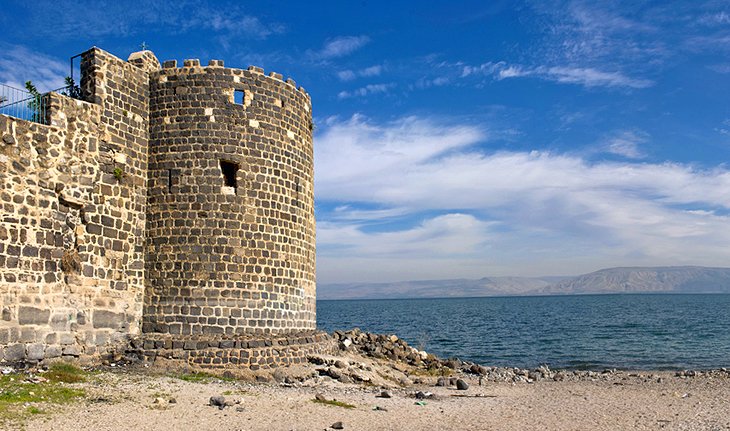
Sitting on the edge of the Sea of Galilee, Tiberias is the perfect base to explore this region.
The waterside street, Yigal Alon Promenade , is home to most of the town's tourist attractions and is a great place for a lakeside stroll. Along this road, you'll find the 19th-century Church of St. Peter , built over the remains of a Crusader castle. There's a beautiful cloister inside, and the apse of the church is projected like the bow of a ship - a reference to Peter's fishing boat.
Just around the corner on HaYarden Street is the sculpture park known as the Open-Air Museum .
If you walk south along the promenade, you come to the Greek Orthodox Monastery , erected in 1862. If you head inland from the sea, Tiberias is home to a number of important Jewish tombs .
About 300 meters from the northern end of HaGalil Street is the tomb of the great philosopher and physician Maimonides (Rabbi Moses Ben Maimon, also known as Rambam).
Born in Córdoba in 1135, Maimonides left Spain because of religious persecution and went to Cairo to become Saladin's personal physician. While there, he also became the spiritual leader of the Jews in Egypt. As well as the tomb there is an excellent museum here dedicated to his life and work.
The tomb of Yohanan Ben Zakkai - who, after the destruction of Jerusalem in AD 70, founded a Jewish school in Yavne and transferred the seat of the Sanhedrin to that town - is also near here.
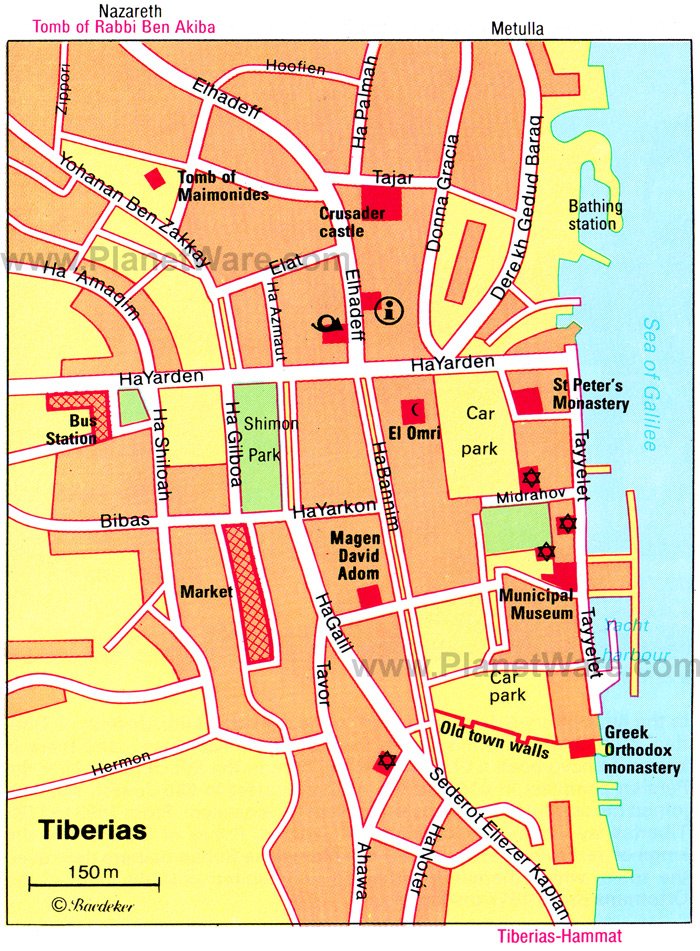
Tiberias has been famed as a spa center since the Roman period, and its hot springs, two kilometers south from town, are as popular now as they were then.
Soaking in the various hot pools here, fed from the natural springs, are the perfect relaxing antidote to time spent on the road traveling.
After you've had your dip, the Hamat-Tiberias hot springs area is also home to its own major tourist attraction. One of the best preserved ancient synagogue mosaic floors in the country was excavated here.
The synagogue dates from the 4th century, and the mosaic floor showcases the influence of both Hellenistic and Roman cultures on the local artists of this period, even when decorating religious buildings. In particular, note the central section of the mosaic, which depicts the sun god Helios surrounded by the signs of the zodiac.
Address: Hamat-Tiberias National Park
The archaeological site of Bet Yerah ("house of the moon," also known as Khirbet Kerak) is not mentioned in either Biblical or Egyptian records, but excavations here have uncovered evidence of a settlement dating from the Bronze Age right through to the period of Arab rule.
The site, 10 kilometers south of the Hamat-Tiberias hot springs, includes a jumble of remains dating from various eras. The best preserved remnants include a bath complex dating from the 4th or 5th century and a 3rd century Roman fort. There is also a Byzantine church and a three-aisled synagogue dating from the 5th century.
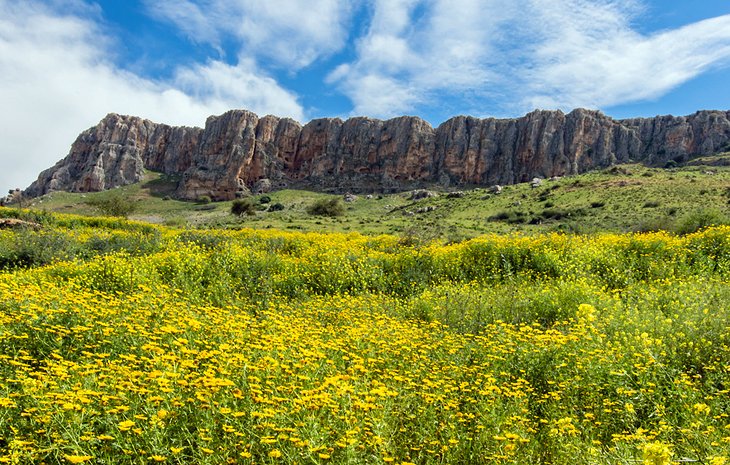
Arbel National Park is a wonderful place to put your hiking shoes on and hit the trail.
The major attraction here is the walk up to the Horns of Hittim - the scene of a decisive battle during the Crusader period. On July 4th, 1187, Saladin inflicted an annihilating defeat on the Crusaders here. The Latin kingdom founded 88 years before now lost its capital, Jerusalem , and much of its territory, and for the remaining 104 years of its existence, it was confined to a narrow coastal strip with its capital at Acre ( Akko ).
It is a half-hour walk to the top of the hill on a footpath running up from the main road. From the summit, where there are Bronze Age remains, are fine views of Eastern Galilee and the Sea of Galilee.
Location: 10 kilometers west of Tiberias
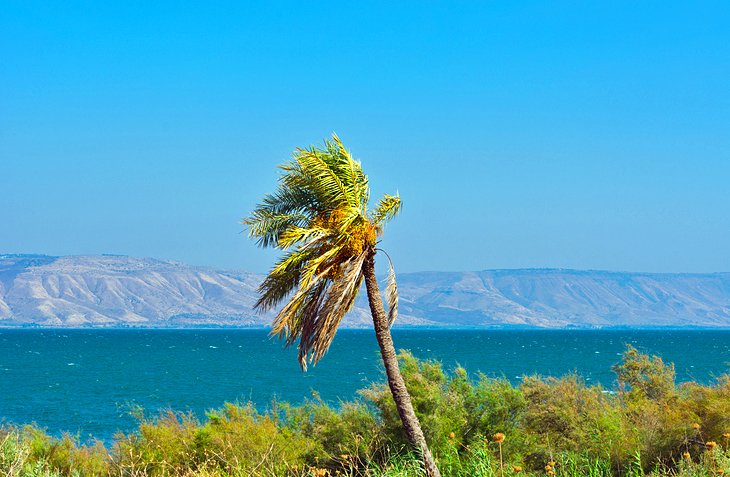
The principal attraction of this little kibbutz is the ancient fishing boat, now known as the Sea of Galilee Boat , displayed here in the Beit Yigal Allon Museum.
Discovered in 1986, buried in mud near the edge of the lake, the boat has been dated to between 70 BC and AD 90, meaning that it could have been in use during the time of Jesus.
The boat is 8.27 meters long and 2.3 meters wide and is made out of cedar wood.
Although there is absolutely no proof that the boat could have been used by Jesus or one of his disciples, many people have nicknamed it the Jesus Boat. Historically, the boat is extremely important for providing archaeologists with an example of 1st-century-AD boat design.
Location: 9.5 kilometers north of Tiberias
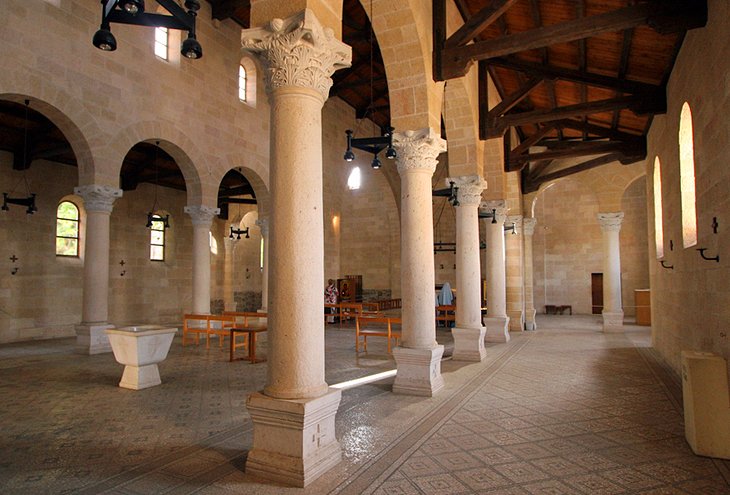
The Church of the Multiplication of Loaves and Fishes is built over the site where tradition states Christ stood during the miracle when he fed the 5,000 people.
Built in 1982, designed by the Cologne architects Anton Goergen and Fritz Baumann, it stands over the site of an earlier Byzantine-era church and has preserved original elements of the older church within the interior.
The Byzantine period mosaics on the flooring are the church's most distinctive feature, depicting a variety of birds and floral designs. The most interesting mosaics are in the transepts.
The artist was evidently familiar with the Nile Delta and has depicted the flora and fauna of that region with flamingos, snakes, herons, ducks, lotus flowers, and reeds. The south transept also shows a Nilometer (a device used for measuring the level of the river).
The altar in the sanctuary is built over the stone on which Christ is said to have stood when the miracle was performed.
In front is the church's most famous mosaic, depicting a basket containing loaves and flanked by two fish.
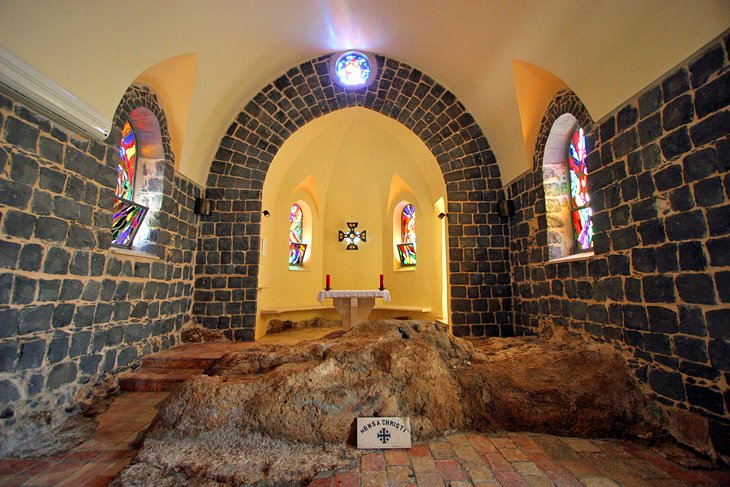
Just 200 meters farther along the road to Capernaum from the Church of the Multiplication of the Loaves and Fishes, a footpath runs down to the shores of the Sea of Galilee and the Church of the Primacy of St. Peter.
A chapel built here in the 4th century was destroyed in 1263, and the black basalt present-day church was built by the Franciscans in 1933.
The church commemorates the appearance of the risen Christ to his disciples on the shores of the lake, when he gave Peter primacy over the church.
The rock at the east end of the church is supposed to be the table at which Christ dined with his disciples.
On the south side of the church are rock-cut steps leading down to the lake that were described by the pilgrim Aetheria in about AD 400 as "the steps on which the Lord stood."
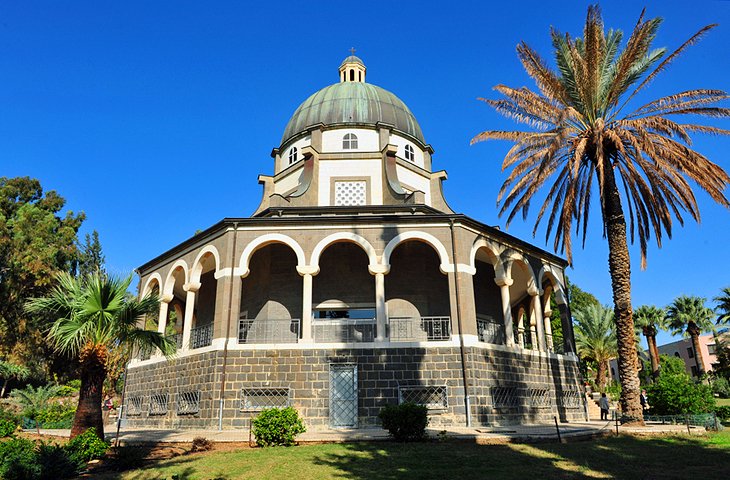
The Mount of Beatitudes is a major point of interest for all Christian visitors. Tradition states that it was here that Jesus delivered his famous Sermon on the Mount .
The Roman Catholic Church here (built in the 1930s) holds mass hourly between 8am and 3pm for the pilgrims who travel here.
The immaculately kept gardens are a wonderfully tranquil spot to take in the views over the Sea of Galilee, while inside the church itself is a lovely stained glass window depicting the Beatitudes.
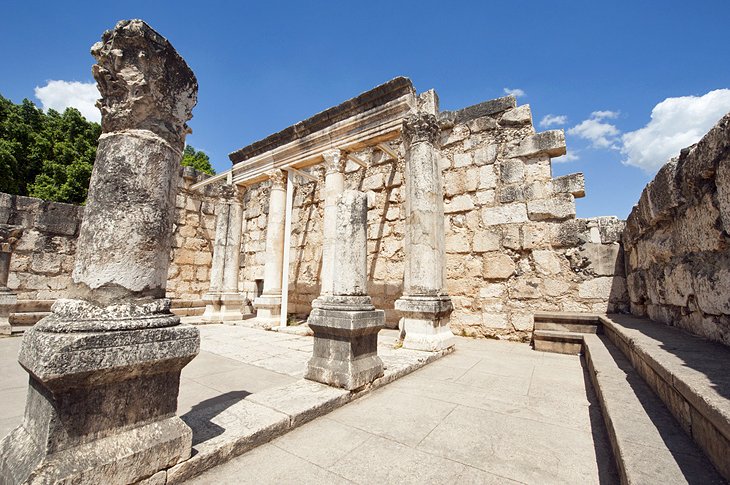
This archaeological site is believed to be the fishing village of Capernaum mentioned in the New Testament where Jesus lived, preached, and gathered the first of his disciples.
The beautiful remains of a fourth-century synagogue are the most prominent ruins here, while the modern church on the site is built over the remnants of a Byzantine church and the ruins of the House of St. Peter .
Archaeological work here has established that the site dates back to the 2nd century BC and was finally abandoned during the 11th century.
Location: 3 kilometers from Tabgha
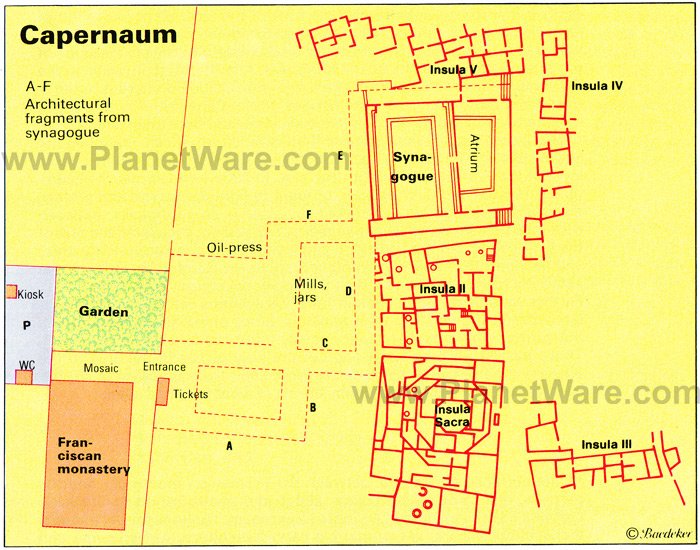
Well worth a visit, this beautiful and rather striking red-domed church is a major landmark along the Sea of Galilee.
It was built on the shore in 1925 by the Greek Orthodox Church and is well worth a visit for its interior of beautiful Byzantine-style frescoes painted in the late 1990s.
In particular, don't miss the vivid fresco depicting the Last Judgement that covers the church's back wall. The garden here is a shady spot to escape the heat of the midday sun.
Location: Capernaum, 3 kilometers from Tabgha
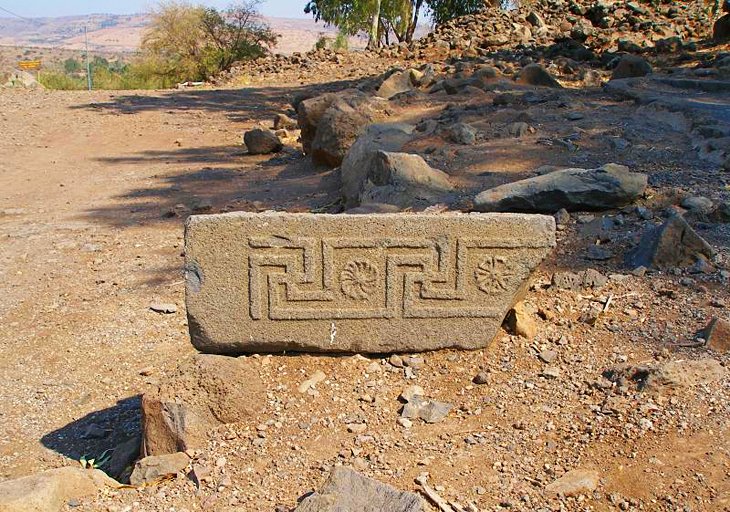
These basalt ruins are believed to be the remnants of the New Testament town of Bethsaida, where Jesus performed the miracle of walking on water, and they are also near the site where he fed the 5000 and cured a man of blindness.
As the ruins are mostly only foundations and low stone walls, it can be difficult to imagine what this once quite substantial town looked like. Information boards placed at strategic points around the excavations help visitors interpret the site.
Location: 23 kilometers northwest of Tiberias
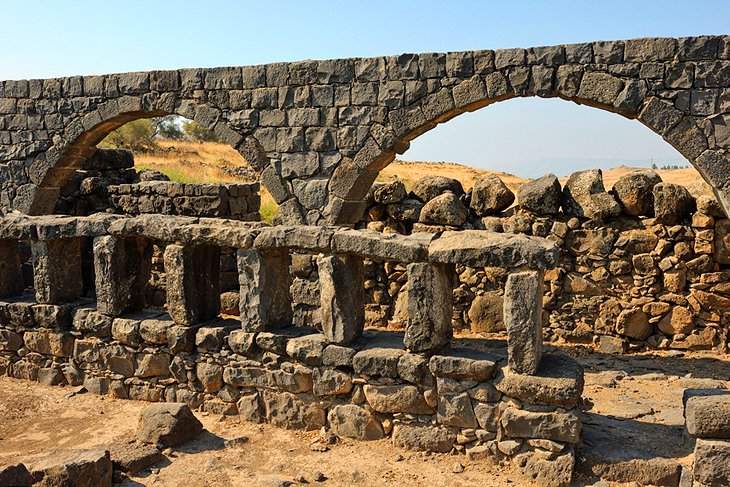
These atmospheric basalt ruins are the remains of another town from the time of Jesus.
The ruins sit on a hilltop on the Sea of Galilee's northern side. Archaeological work here dates the site back to the 1st century AD, although the ruins present today all date from the later Byzantine era.
The main highlight of a visit here is the 4th-century synagogue (where a horde of coins was found during excavation), which is home to beautiful carvings with Hellenistic influences.
Location: 29 kilometers north of Tiberias
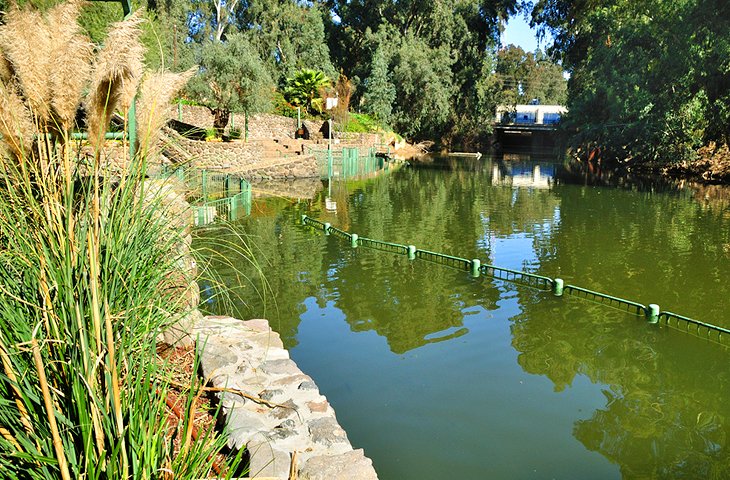
Near the headwaters of the Jordan River, Yardenit is a popular baptism spot for Christian pilgrims looking to dunk themselves in the famous waters of the Jordan.
The site is maintained and managed well, with 12 separate baptism pools built along the lush river bank to aid visitors who want to immerse themselves, as well as a wooden riverbank promenade for those who just want to experience the quiet tranquillity of the river.
There's also a restaurant on-site.
Location: 11 kilometers south of Tiberias
Official site: www.yardenit.com
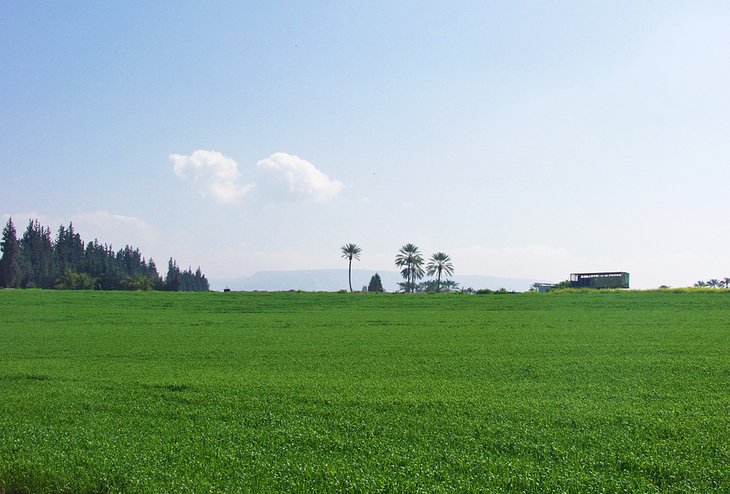
The kibbutz of Degania lies at the point where the Jordan River emerges from the Sea of Galilee.
This was the very first kibbutz, founded in 1909 by Russian immigrants, with the original kibbutz now known as Degania A, and its more recently-founded neighbor as Degania B.
At the main entrance to Degania A is a Syrian tank, which in 1948, advanced as far as the kibbutz, but was then knocked out by a Molotov cocktail.
Within the territory of the kibbutz is Gordon House (named after Aharon D. Gordon, one of the founders of the kibbutz), a research institute with an archaeological, natural history, and agricultural museum.
Location: 2 kilometers south of Bet Yerah
When the Israelites took possession of the Promised Land, the tribes of Naphtali, Zebulun, and Asher settled in Galilee (Joshua 19), where they were later joined by the tribe of Dan (Judges 18).
In the eighth century BC, the country was occupied by the Assyrians; later came Babylonians, Persians, and Greeks. After the Hasmonean conquest in 163 BC, non-Jews lived in the coastal plain and Jews in the upland regions.
When the Romans occupied Galilee, it was ruled, along with Judaea, by the Hasmonean ruler Hyrcanus II and then by Herod the Great. Thereafter, in the lifetime of Jesus, it belonged to the tetrarchy of Herod Antipas, who made Tiberias his capital, and then, until 44, to the kingdom of Herod Agrippa.
In AD 66, Galilee was a stronghold of the Jewish uprising against the Romans, and after the Bar Kochba rising (AD 135), it replaced Judaea as the center of Jewry; the towns of Bet Shearim, Sepphoris (Zippori), and Tiberias being of particular importance in this connection.
From the seventh century onwards, the Arab population of Galilee increased steadily. The first Jewish settlements of modern times were established at Rosh Pinna (1878) and Metulla, the most northerly village in Israel (1886). In 1948, Galilee became part of the newly founded state of Israel.
We recommend these convenient hotels and guesthouses in Tiberias near the sea:
- The Scots Hotel : This luxury boutique hotel is a former 19th-century Scottish hospital. If offers lake views, large rooms, and a full-service spa.
- Leonardo Plaza Hotel Tiberias : This is a great mid-range seafront resort with a lovely outdoor pool, kids' club, and comfortable beds.
- Ron Beach Hotel : For an affordable waterfront hotel, it's hard to beat this property, where you'll find a private beach, floor-to-ceiling windows, and inviting pool, and a children's playground.
- Villa Roca Tiberias : This budget-friendly bed-and-breakfast is in a central location and housed in a stone building.

More on Israel
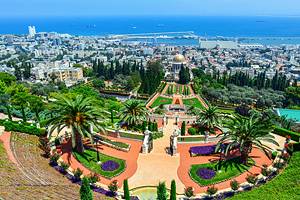
Our local experts can design your trip based on your preferences
Warning - You are using an outdated browser. Please upgrade your browser to properly view this website.

- Destinations
- Africa middle east
- The galilee
The Galilee travel guide
A white-robed Druze puffing away on his pipe in a mountain-top village; a bikini-clad bather soaking in sulphuric springs at a Roman bathhouse; on the one hand the Christian landmarks of Nazareth , where Christians can retrace the steps of Jesus, and on the other Safed of the Kabbalah, where Jews can reflect on the place that produced their greatest mystic: these are the stark contrasts typical of Israel’s dynamically diverse north.
Where great battles were fought
This relatively compact region which can suddenly explode into a blaze of unusual blood-red buttercups and purple irises extends northwards from the lush Jezreel Valley. It lies on the main artery that linked the ancient empires, and has been a battleground for Egyptian Pharaohs, biblical kings, Romans and Jews, Christians and Muslims, Britain and Turkey.
From kibbutzim to Bedouin tribes
Jewish pioneers established the country’s first kibbutzim here. In subsequent decades the kibbutzim have mushroomed to cover much of this region, where tribes of Bedouin still live and Arab and Druze villages lie nestled in the hills. A circular tour of the entire Galilee could easily be achieved in a day’s leisurely drive – but even over the course of a much longer tour the visitor would get only a passing appreciation of the Galilee's incredible history, sacred sites, and diverse inhabitants.

Places to visit in the Galilee
Tel megiddo (mount megiddo).
tel: 04-659 0316
On Highway 66, 2km (1.3 miles) to the north from Megiddo Junction
In the center of the Jezreel (Izre’el) Valley, in the heap of ruins that make up the tel (mound) of Megiddo, archeologists have uncovered 20 cities. At the visitors’ center a miniature model of the site gives definition to what the untrained eye could see as just a pile of stones, breathing life into what is actually a 4,000-year-old Canaanite temple, King Solomon’s stables (built for 500 horses), and an underground water system built by King Ahab 2,800 years ago to protect the city’s water in times of siege. Steps and lighting enable easier exploration of the 120-meter (390ft) tunnel, and of the almost 60-meter (200ft) high shaft, which was once the system’s well.
The sacred town where Jesus Christ spent much of his life is today a bustling city, Nazareth. Read more about Nazareth...
Sheltered by the highest peaks in the Galilee, hilltop Safed seems also to be sheltered from time itself. This enclave of bohemian artists and Orthodox Jews is where the mystical texts of the Kabbalah were once penned and every synagogue here is wrapped in its own set of legends. The narrow, cobblestoned streets of the original city core wind their way through stone archways and overlook the domed rooftops of 16th-century houses. Devout men, clad in black, congregate in medieval synagogues, the echo of their chants filling the streets.
Sea of Galilee (Yam Kinneret)
Glowing like an emerald, its tranquil surface framed in a purplish-brown halo of mountains, the Sea of Galilee is probably the most breathtaking lake in the country. At 21km (13 miles) long and 11km (7 miles) wide, with a depth of no more than 45 meters (150ft), it may not be enormous by global standards, but it has, through some romantically inspired hyperbole, come to be known as a “sea”. In Hebrew it is called Yam Kinneret because it is shaped like a kinnor , a harp. Here, the dramas of the past have now faded into the idyllic landscape: today it is new water sports, not new religions, that are hatched on these azure shores.
Tiberias (Tverya)
The capital of the Sea of Galilee area, Tiberias has become known for its “fun in the sun” spirit and is one of the country’s most popular resorts. On its new boardwalk, lined with seafood restaurants, you can dig into delicious St Peter’s fish while enjoying a stunning view of the lake. On the marina, take your pick of water-skiing or windsurfing, or go for a dip at one of the beaches along the outskirts of the city. With all the distractions available in this popular playground, it’s easy to forget that Tiberias is considered one of the four holy Jewish cities. But for historians and hedonists alike, Tiberias’s main draw are the hot springs less than a kilometer south of Tiberias city center. The therapeutic properties of the springs have been exploited for centuries and a range of spa treatments is available, from whirlpools to electro-hydrotherapy.
Average customers rating

{{_ "pagesAdmin.destinations.overviewCulturalFeaturesIn"}} {{currentName}}
{{_ "pagesAdmin.destinations.overviewViewAllFeatures"}} {{currentName}}
{{_ "pagesAdmin.destinations.overviewHistoricalHighlights"}} {{currentName}}
{{_ "pagesAdmin.destinations.overviewViewAllHighlights"}} {{currentName}}
Places to visit in The galilee
Read more from the travel guide to Israel
- Top attractions
- Historical highlights
- Cultural features
- Plan your trip
- Top restaurants
- Top cafes and bars
- Useful phrases

Monday - Friday 9:00 AM - 5:30 PM, Pacific Standard Time

Galilee Travel Guide

The Galilee, a popular tourist region for Christian tours to the Holy land is a mountainous, fertile region in northern Israel. It's known for the Sea of Galilee, where Jesus began His ministry and is said to have walked on water. The city of Tiberias is on the shores of the Sea of Galiee, also known as lake Kinneret, and is home to the tomb of Jewish sage Maimonides, and the Church of St. Peter, with artwork depicting the 4 Gospels. The Mount of Beatitudes is nearby and is where it’s believed Jesus preached the Sermon on the Mount. Yardenit Baptismal Site, is a baptism site located along the Jordan River situated on the southern shores of the Sea of Galilee.
The Cove of Tabgha and the Church of Multiplication are situated on the northern shores and is believed to be the site of the Gospel story of the Multiplication of Loaves and Fishes. The town of Capernaum referred as Jesus “own town” contains the ruins of an ancient synagogue, and is where the home of Peter’s mother-in-law lived and was healed as mentioned in the Scriptures. The Hula Valley, a nature reserve surrounding Hula Lake, is home to migrating birds. Safed, a hilltop city, is known for its artists’ quarter and as a former center of Kabbalah. In the region’s northwest is the hilltop 13th century Montfort Fortress, a Crusader castle above a flour mill and the remains of a dam. Nazareth is the town where Jesus grew up, and is home to the Basilica of the Annunciation.
- Church of the Annunciation
- Mount of Beatitudes
- The Beatitude Monastery
- Church of the Primacy of Saint Peter
- St. Peter's Church, Capernaum
- Capernaum National Park
- Yigal Allon House
- Tomb of Maimonides
- Hamat Tiberias
Popular tours
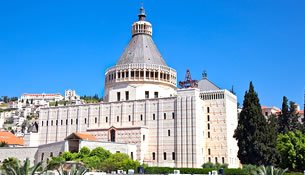
Nazareth and Galilee Tour
1 Day│ Touring day in Nazareth and Sea of Galilee ; Nazareth, Basilica of Annunciation, Church of St. Joseph, Tiberias, Sea of Galilee, Capernaum, Golan Heights, Yardenit - Jordan River..

Galilee Tour
2 Day│ Two days in Galilee ; Nazareth, Basilica of Annunciation, Church of St. Joseph, Tiberias, Sea of Galilee, Capernaum, Tabgha, Golan Heights, Yardenit - Jordan River, and Israel coast Caesarea, and more.
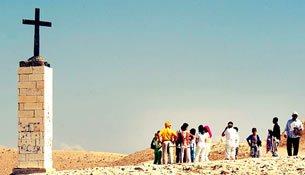
Footsteps of Christ Tour
10 Days│ Including 2 nights in Galilee ; Nazareth, Mount Precipice, Basilica of Annunciation, Cana, Sea of Galilee, Tiberias, Magdala, Kibbutz Nof Ginosar, Golan Heights, Banias, Hula Valley, Yardenit, Mount of Beatitudes, Church of the Beatitudes, Tabgha, Church of Multiplication, Capernaum.
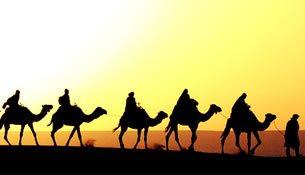
Where it all Began Tour
15 Days │ Incuding 2 nights in Galilee ; Nazareth, Mount Precipice, Basilica of Annunciation, Cana, Sea of Galilee, Tiberias, Magdala, Kibbutz Nof Ginosar, Golan Heights, Banias, Hula Valley, Yardenit, Mount of Beatitudes, Church of the Beatitudes, Tabgha, Church of Multiplication, Capernaum.
When to tour
High season Israel tours to the Galilee - Tiberias area are Apr–Aug, when the weather's warm, sunny with little rain. Extreme hot weather are common Jul–Aug. Winter Dec–Feb is mild with regular rain. The Tiberias International Marathon (Jan) is held on a fast course beside the Sea of Galilee.
Travelers from North America typically stay 1–3 days.
Current weather for the week in Tiberias:
Average monthly temperatures in Tiberias:
Current weather for the week in Nazareth:
Average monthly temperatures in Nazareth:

- Travel Guide: Israel
- Region: Galilee
We’re not taking new bookings for travel to Israel and the Occupied Palestinian Territories at the moment. Our specialists can advise you on all the destinations you can currently book with us.

Change location
- Call us today until 5pm
- 01993 838 925 01993 838 433 or
- REQUEST A QUOTE

Visit Galilee, Israel and the Occupied Palestinian Territories
- Things to do
Israel’s largest freshwater lake, the Sea of Galilee is also known as Lake Tiberias or Lake Kinneret and is the place where Jesus is said to have walked on water. According to the Bible, much of his ministry was carried out around the lake, and today, it’s an important Christian pilgrimage site. The lake is one of Israel’s prime water sources and a popular place for relaxing on its beaches, cycling or walking. Many sites connected with biblical stories are in the surrounding region as well as Israel’s first kibbutz, making it an ideal place to learn about the history of the region and its people.

At Tabgha on the northwestern lake shore is the Church of the Multiplication of the Loaves and Fishes. This Benedictine church was built in 1982 to protect the remains of a 5th-century church, its floor of 4th-century mosaics and the earlier foundations of a 3rd-century church. The hub of it all is a rock which protrudes from the floor below the altar, the spot where Jesus is said to have laid the five loaves and two fishes that went on to feed 5,000 people.
Nearby is the Church of the Primacy of Saint Peter, a Franciscan chapel built in 1933 with a set of vivid stained-glass windows. Another rock here stands in front of the altar and is believed to be where Jesus sat and ate with his disciples.
Uphill from Tabgha’s Church of the Multiplication of the Loaves and Fishes is the Mount of the Beatitudes, the place where Jesus is believed to have delivered the Sermon on the Mount. The spot is marked by an octagonal Italianate church built in the early 20th century. Stained glass below the dome depicts the beatitudes, with the seven virtues (faith, hope, charity, fortitude, justice, temperance and prudence) depicted around the altar. Don’t miss the sweeping views of the Sea of Galilee from the balcony and the tranquil gardens.
At the southern end of the lake you’ll find the Deganya Alef and Deganya Beth kibbutz. Deganya Alef was the first of Israel’s collective farms, founded in 1910 by a group of young people eager to create a just society. This was Israel’s first kibbutz and the success of the commune saw countless others established across the country, including Deganya Bet in 1920.
You can visit Deganya Bet to gain insight into the history and present-day reality of kibbutz life. A guide from the kibbutz will explain the theoretical foundations of the kibbutz movement and important role the kibbutzim played in the history and defence of the early state of Israel.
They will also speak about what life is like on a kibbutz today and current challenges faced by modern life. As part of the tour you’ll see the archives, located in the converted home of Levi Eshkol, a former prime minister of Israel, that contain fascinating material on the early days of the pioneer movement.
Best time to visit Galilee
Although Galilee is considered a year-round destination, April or May or between September and November are the best times to visit as you’ll avoid the heat and humidity of the summer months. Winters are cool and can be wet, but are often the most tranquil time to visit rural Israel.

Start planning your tailor-made trip to Galilee by contacting one of our Israel and the Occupied Palestinian Territories specialists
- 01993 838 925 01993 838 433
- Make an enquiry
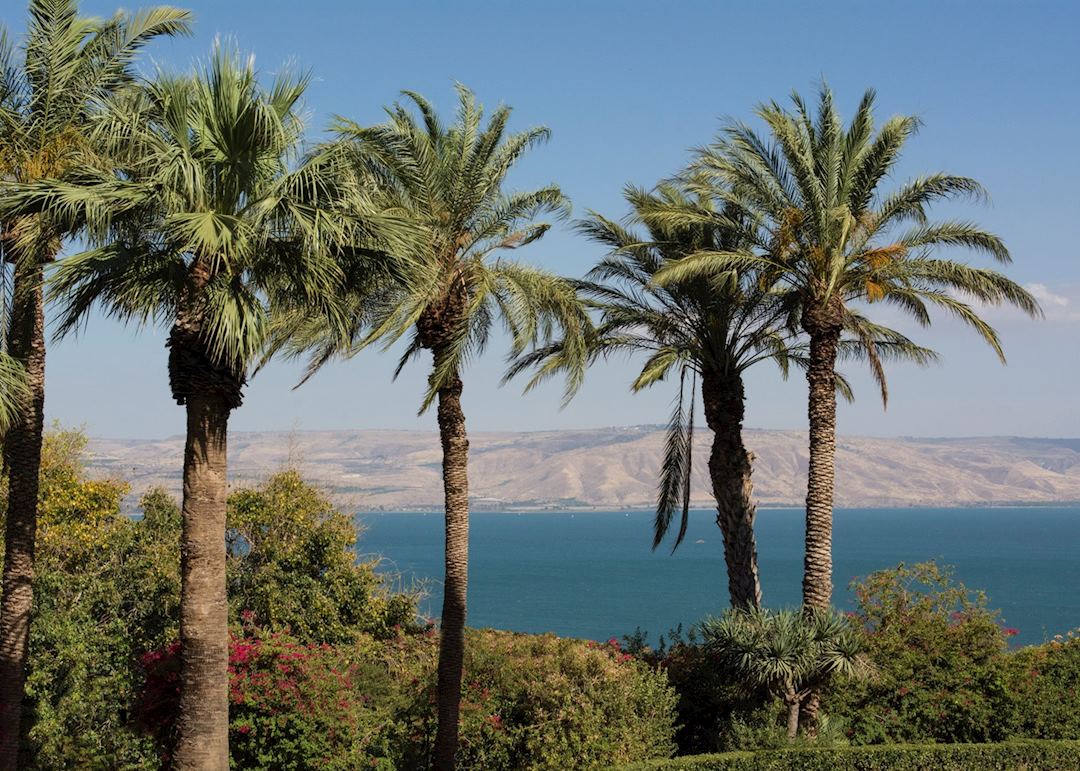
Start planning your trip to Galilee
Map of galilee, places & hotels on the map, places near galilee.
- Nazareth 15 miles away
- Acre 28 miles away
- Jericho 65 miles away
- Tel Aviv 66 miles away
- Jerusalem 73 miles away
- Bethlehem 78 miles away
- Negev Desert 150 miles away
Photos of Galilee

Our expert guides to exploring Galilee
Written by our specialists from their own experiences of visiting Galilee, these guides will help you make the most of your time there. We share both our practical recommendations and the best ways to appreciate Galilee at its best.

Highlights of Israel and the Occupied Palestinian Territories
Israel and the Occupied Palestinian Territories is beguilingly complicated. From the heart of Jerusalem’s Old City to the sere, sweeping vistas of the Negev, explore the historical and religious significance of this country with Olivia from our Israel team.
Ideas for experiencing Galilee
Our specialists seek out authentic ways to get to know the places that could feature in your trip. These activities reflect some of the experiences they've most enjoyed while visiting Galilee, and which use the best local guides.
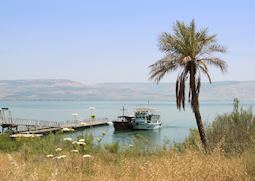
Highlights of the Sea of Galilee
Discover the site of much of Jesus’ ministry on a guided tour of the highlights of the Sea of Galilee, the place where Jesus gave the Sermon on the Mount, multiplied the loaves and fishes, and met the first of his disciples.
Search the Learning Center
The Sea of Galilee is one of the most central areas to the ministry of Jesus during His life on Earth. Nearly 70% of Jesus’ ministry took place near, beside, or even on top of (literally) this body of water.
What is the Sea of Galilee?
Here is what you need to know: the Sea of Galilee is the largest freshwater lake in all of Israel. Yes, it is in fact a lake, even though the Gospels call it a sea. But we will use “sea” and “lake” interchangeably, because let’s be honest, it is known as both.
If you look at a picture of the Sea of Galilee on a map, its shape resembles a harp. Because of this, it earned its Hebrew name “Kinneret”, which means – you guessed it – a harp.
It is also sometimes called Lake Tiberias, and the Bible calls it Lake Gennesaret (or Genezareth) on a few occasions. There are a couple other names too, but we don’t want to confuse you. So, whichever name you choose, it is probably the right one according to some.
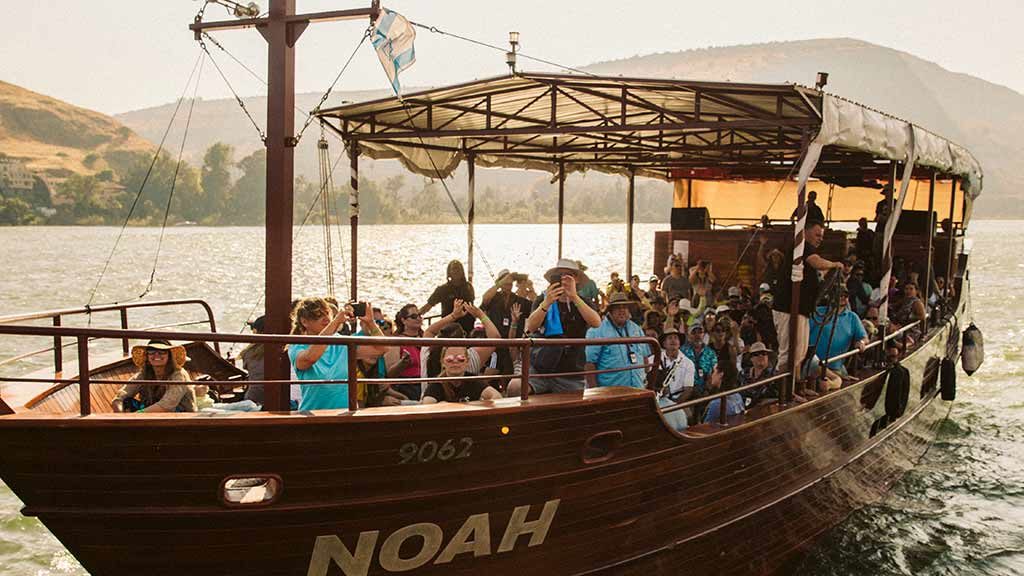
Sea of Galilee Facts
The lake is approximately 8 miles across and, in total, is about 64 square miles in size. It sits around 700 feet below sea level.
To the east of it lie the borders of modern-day Syria and Jordan.
To its west is the region of the Galilee, which includes several cities you might recognize. They are Cana, Megiddo, Magdala, Gennesaret and Capernaum, to name a few. And Nazareth is not too far either! So, in His childhood years, Yeshua lived only about 20 miles west of the Sea of Galilee.
The Life-Giving Lake of Israel
Lake Kinneret is part of the Jordan River. Which means, the Jordan flows into the northern part of the Sea of Galilee, but it also flows out of the southern tip of the sea.
A popular analogy says, the Sea of Galilee is like a righteous man; because living water flows into it and living water flows out of it.
In contrast, the Dead Sea is likened to an unrighteous man, because though freshwater flows into it, nothing flows out of it. It holds what it receives, and because of evaporation it makes the water undrinkable.
But the Sea of Galilee is also life-giving in a very literal sense. The lake has been the source of drinking water not just for Israel, but also for Jordan! Today, Israel has also other supplies of water (which they also share). But the fact remains that the lake is very precious to both countries.
Jesus and the Sea of Galilee
Judging by the amount of time He spent near it, Yeshua (Hebrew name of Jesus) must have really enjoyed the Sea of Galilee and its surroundings. But the hills and mountains around it mean that its waters were (and are!) often troubled by storms. And Jesus famously silenced them.
On the shores of the lake, Jesus called His first disciples and performed miracles. Also here, He often spoke of the Kingdom of God and fed thousands. By the Sea of Galilee, Jesus shared His most recognized message, later named “Sermon on the Mount”.
Do you want to learn more about the specific locations for these events? Then read on!

Jesus’ Ministry in the Galilee: a List
According to the Gospels, here are some of the significant locations where Jesus ministered to the people near the Sea of Galilee:
Mt. of Beatitudes and Tabgha
This northern point of the sea is where Jesus gave His most well-known teaching. This address is commonly called the Sermon on the Mount ( Matthew 5-7 ). The Mount on the other hand takes its name from the blessings that Jesus listed at the beginning of His speech.
A site nearby called Tabgha commemorates Jesus feeding the 5,000 (Mark 6). The church in this small parish is famous for its mosaic near the altar. It displays the bread and fish that Jesus multiplied.
Also on the northern shore of the sea, Capernaum is the town near which Jesus called Peter and Andrew to be His disciples (Matthew 4). Many see this as the “home base” of Jesus’ ministry.
Here Jesus healed the servant of the Roman centurion (Matthew 8). And also where the paralytic was lowered from the roof and healed (Matthew 9).
Today’s Capernaum holds the remains of a synagogue that dates back to the days of Yeshua’s life on Earth. Somewhere among the ruins of this ancient town could have been Peter’s home.
Located near the northeastern area of the sea, the place became known after Yeshua healed a man there who was born blind. Jesus used His spittle and laid hands on him, giving him sight. This is the same man who first replied to Jesus that he saw men as trees walking (Mark 8).
Kursi or Golan Heights
This vast, mountainous region is also northeast of the sea. As we read in the Gospels, this is where Jesus cast the legion of unclean spirits into a herd of swine. The pigs ran down the banks of the sea and drowned (Mark 5).
This city on the northwestern border of the sea was the hometown of Miriam who followed Jesus. Known better as Mary Magdalene (Miriam of Magdala ), she chose to follow Yeshua, after He cast out 7 unclean spirits out of her (Luke 8).
This unique cliff stands nearly 600 feet tall, overlooking the entire region of the Sea of Galilee. Many believe this wasf the most likely location where Jesus shared the Great Commission ( Matthew 28 ).
From this cliff you could see most of the areas where Yeshua’s ministry actually took place.
The River Jordan and Yardenit
You can see the Jordan River and even go swimming in it both north of the lake and south of it. On the southern side of it, you can find a site today that is dedicated to Yeshua being baptized by His cousin, John the Baptist (John 1).
The actual event likely took place much further south down the river. Probably as far south as Jericho. Nevertheless, Yardenit remains a special site for Christians, where they can even get an opportunity to get baptized themselves.
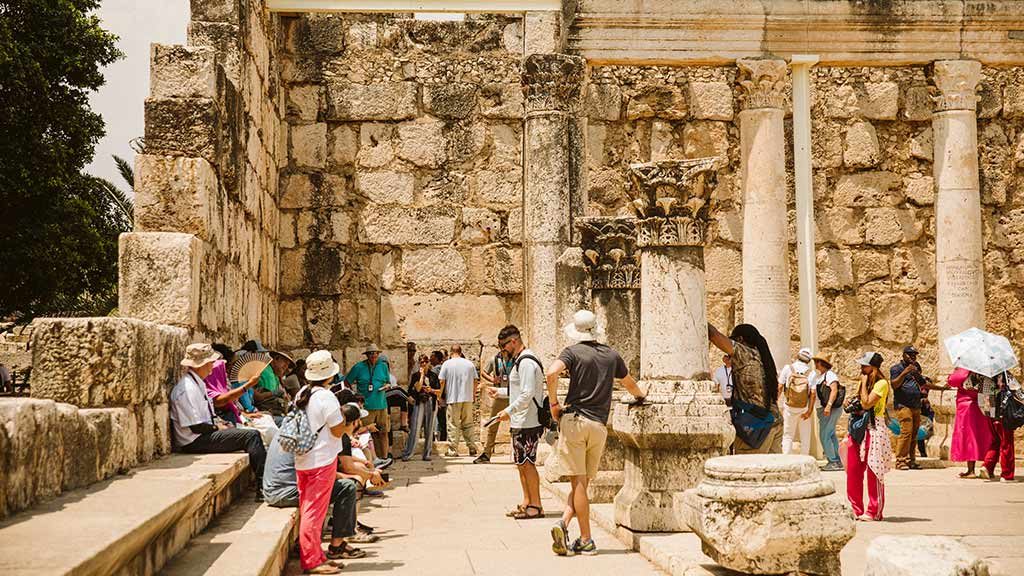
The Waters of the Sea of Galilee
We’ve been talking about the Sea of Galilee all this time, but we cannot wrap things up without specifically mentioning its waters.
It’s important to note that two miracles of Jesus (at least!) happened actually ON the sea. First, as we already mentioned, He calmed the storm. Jesus was in the boat with his disciples when a rough storm broke out. The disciples woke Him up and He restored peace (Mark 4).
On another occasion, Jesus stayed on the coast while His disciples were out in the sea fishing. He walked towards them on water, as described in Mark 6, and Peter boldly stepped out of the boat towards Jesus.
Visit the Sea of Galilee in Israel!
If you’ve ever wondered, “What is the most central location to Jesus’ ministry?” Or, “What area should I visit in the land of Israel?” , think north!
After you land in Tel Aviv and soak up the atmosphere of Jerusalem, you cannot miss out on the Galilee region of the promised land. The area of the Sea of Galilee is just as beautiful today as it must have been in Jesus’ day.
And here’s some extra information you will love: If you join us on a Jerusalem Encounter tour, you will not only visit the Galilee — you will also get a chance to meet the local believers. So sign up today!
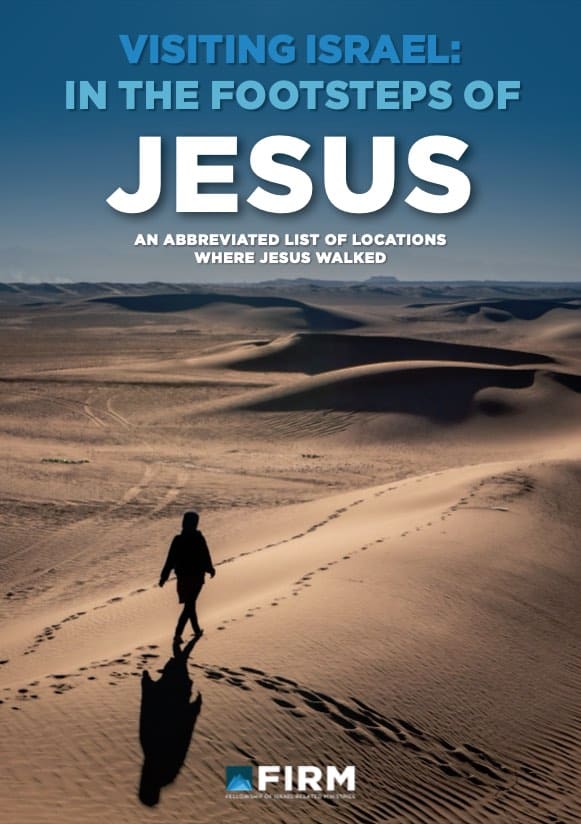
Visiting Israel: In the Footsteps of Jesus: Free PDF Download
It is quite exciting to think that while touring Israel you are walking on the same land that Jesus did.
Whether it is the reason why you came to Israel or not, it is worth noting which locations were significant to His life and ministry. God chose this piece of land to send His Son to live on earth. Many archeological findings confirm the locations mentioned in the Bible.
Articles Related to the Sea of Galilee
- 10 Places Where Jesus Walked in Israel from Scripture
- Crossing the Jordan River and Its Spiritual Significance
- The Literal Intent of the Prophets
- What Can We Learn from the Dead Sea Scrolls?
- Sharing the Gospel in the Sharon Region of Israel
Estimated reading time: 5 minutes
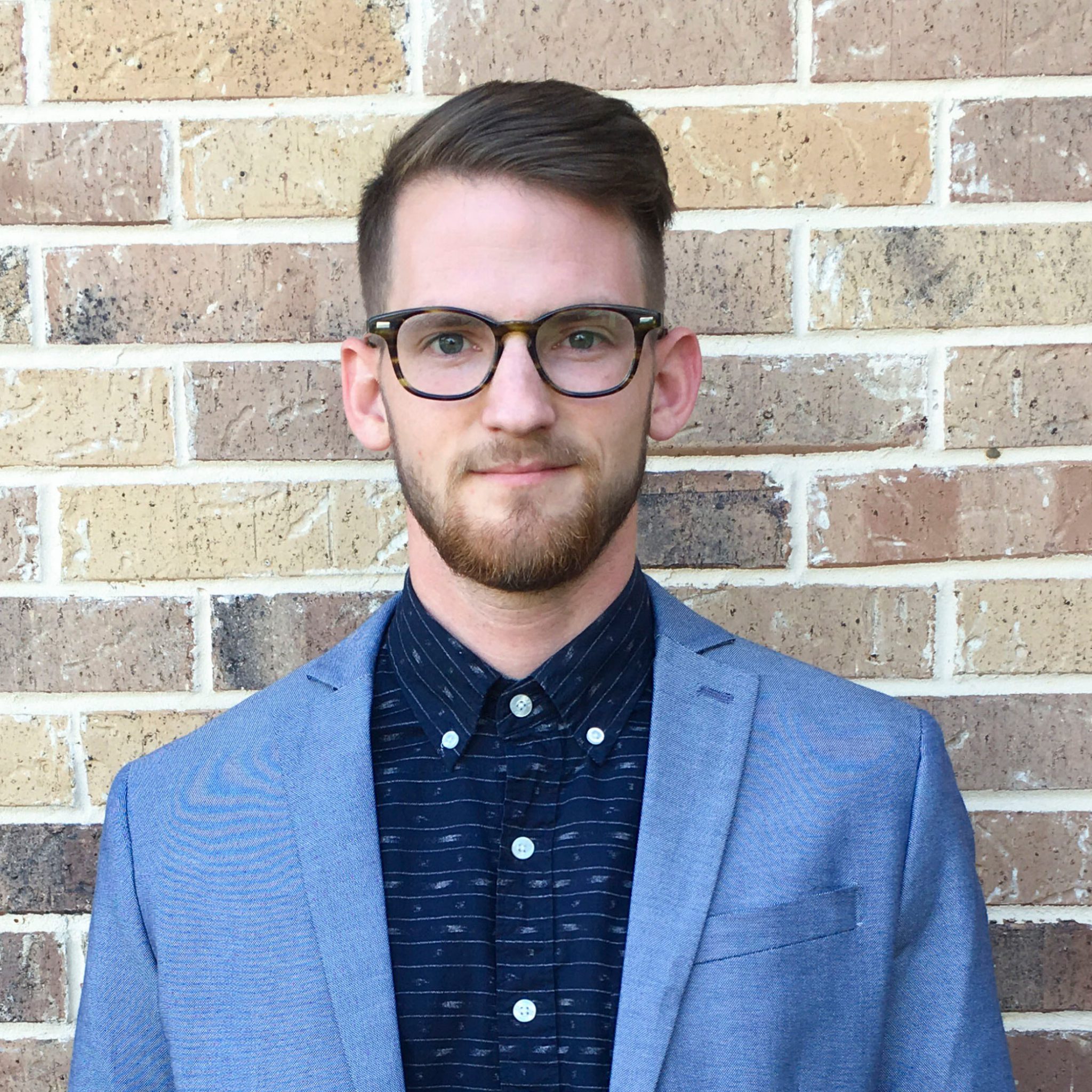
Share this with your friends

Most of northern Israel is generically known as The Galilee (Galil in Hebrew). It stretches virtually from the Mediterranean to the harp-shaped Sea Of Galilee and River Jordan on whose shores vast history has been made. Here is Mount Gilboa where King Saul and his son, Jonathan, died in battle against the Phillistines. Here is Hazor, where Deborah killed Sisera. Here, at Mount Meron, is the grave of Rabbi Hillel. Here in Tzippori, Hamat Tveriya and Bet Alpha, gorgeous 1,800-year-old synagogue mosaics have been discovered. Here is Armageddon (Megiddo) where Solomon built giant stables. Here is the lakeshore city of Tiberias, one of the “Four Holy Cities of Judaism” (another is Galilee’s Safed), which reached fame 2,000 years ago as one of the chief locations in which the Talmud was written.
The restoration of the Jewish homeland in the period beginning in the 1880’s was largely centered in the Galilee, and in the ensuing 130 years a much neglected landscape of not much more than olive trees has been transformed into one of the most fertile areas in the world. Here are dozens of kibbutzim and independently owned farms – whose produce feeds not only Israelis but is also flown daily to the grocery stores and flower markets of Europe. Here are some of Israel’s 300+ vineyards producing award winning wines. And here are pretty villages, towns and cities including Nazareth and Carmiel.

In addition to hotels and very comfortable kibbutz guest houses, the Galilee is filled with dozens of country bed-and-breakfast accommodations, known as zimmerim. Many offer luxurious accommodations, including pools, and make a delightful base for relaxing and touring.

- LET'S TALK
- LIFE & CULTURE
- LET'S EAT
- FAMILY & EDUCATION
- SOCIAL & PERSONAL
- JEWISH WORDS
- JEWISH HOW TOS
- RABBI I HAVE A PROBLEM
- EDUCATIONAL
- PROFESSIONAL
- THE FRESSER
- THE SCHMOOZE
Sign up to The JC newsletter
Israeli killed by hezbollah anti-tank rocket in galilee.
The fatality was named as Sharif Suad from the Bedouin town of Sallama, located in the Galilee

BY JC Reporter

An Israeli was killed overnight Thursday in a Hezbollah anti-tank missile attack on the Mount Dov region close to the border with Lebanon.
The man was named as Sharif Suad from the Bedouin town of Sallama, located in the Galilee in northern Israel.
Suad was a military contractor conducting "infrastructure activity" when he was struck.
In response, the Israel Defense Forces shelled Hezbollah terror sites in Chebaa, Kfarchouba and Ein el-Tineh, all in Southern Lebanon.
Among the targets hit were a weapons depot and a missile launch site. IDF forces also opened fire "to remove a threat" from Southern Lebanon.
On Sunday, IDF Maj. (res.) Dor Zimel, a deputy company commander in Battalion 8103 of the 6th Etzioni Brigade, succumbed to wounds he sustained in a Hezbollah aerial attack the previous week.
Zimel, 27, from Even Yehuda, just outside the central Israeli town of Netanya, was reportedly set to marry his fiancée next month. He was posthumously promoted to the rank of major.
Nineteen people, including 14 soldiers, were wounded in the missile and drone attack on the northern Bedouin town of Arab al-Aramshe.
Tehran’s terrorist proxy in the Land of the Cedars has carried out near-daily attacks on the Jewish state since joining the war in support of Hamas a day after the October 7 massacre in the northwestern Negev.
A Hezbollah source in the Lebanese parliament told Qatar’s Al-Araby Al-Jadeed outlet on Tuesday that Hezbollah’s terrorism would “increase and reach deep into Israel.”
Hezbollah has killed nine civilians—Israelis as well as a foreign worker—and 11 IDF soldiers since it began its current round of attacks.

Sheryl Sandberg film details horrific sexual crimes committed by Hamas on October 7

Biden welcomes ‘remarkable’ freed hostage Avigail, aged 4, to the White House

Hamas official who advocated for destruction of Israel: We’d accept two-state solution

Widely reported 50 Nova suicides story ‘not correct’ says Israeli psychologist

Rabbis take stand against abuse of Christians in Jerusalem’s Old City
Have the JC delivered to your door

Want more from the JC?
To continue reading, we just need a few details....
©2024 The Jewish Chronicle
- Advertising
- Terms & Conditions
- Cookie Policy
- Privacy policy
Galilee council head: 'If we don't live along the borders, State of Israel will not exist'

Israel's plan to rebuild North, South after war should be comprehensive, proactive
G rowing up in the Golan and being deeply involved in policy planning and decision-making for the government for many years, I’ve observed numerous minimal and repetitive action plans. As Israel faces one of its most significant tests amidst ongoing conflict, a crucial question looms: How can we not only achieve military victory but also emerge socially and economically stronger, especially in our northern and southern regions? The transformation of these areas into thriving regions capable of attracting thousands of new residents over the next decade is essential for our future success. Now is the time for a new approach.
A new approach for ‘the day after’
The current conflict has not only tested Israel’s military resilience but also exposed the vulnerabilities and untapped potential of the northern and southern regions. Reflecting on the past, after the Second Lebanon War , the Israeli government implemented a significant rehabilitation program in the North and Haifa. While this program made important strides in rebuilding infrastructure and supporting local authorities, it highlighted the need for integrating more robust social and economic strategies to ensure comprehensive development. Strategic planning for the future must not merely aim to restore what was lost but should seize this moment to fundamentally transform these areas into thriving hubs of innovation, culture, and economic activity. This vision requires a bold departure from past practices, embracing a more holistic approach that can truly revitalize these communities.
Immediate needs and long-term strategy
Addressing immediate infrastructure needs is essential, but the vision must extend far beyond repair. It is necessary to lay the groundwork for sustainable development that will attract new populations and foster a prosperous environment. This includes building adaptive infrastructure that can withstand future challenges and creating conditions that immediately benefit current and future residents.
Holistic development of the North and South
To transform the North and South into regions that people are drawn to, a comprehensive plan is needed that includes:
• Affordable Housing: Develop comprehensive housing projects that are affordable and enhance the natural beauty of the region, making these areas attractive places to live.
• Education and Employment Opportunities: Strengthen local educational institutions and link them to emerging economic sectors like technology, tourism, and agriculture, ensuring that residents have access to valuable skills and job opportunities.
• Community Building and Social Resilience: Expand social services, healthcare, and recreational facilities to build strong, resilient communities that support a high quality of life and can attract and retain new residents. Recent surveys conducted in the Eastern Galilee highlight the need for secure, stable reintegration strategies, as nearly half of the respondents are currently displaced, emphasizing the urgency of addressing community needs.
Tourism as a catalyst for economic growth
Tourism will be a cornerstone of economic resurgence, particularly in the historically rich regions of the North and South. By developing tourism that highlights the unique history, culture, and natural landscapes of these areas, both domestic and international visitors can be attracted. This will not only boost the local economy but also create numerous employment opportunities, supporting the broader goals of regional development. Importantly, 21% of families in the North rely on tourism for their income, underscoring the vital role that enhanced tourism infrastructure and initiatives could play in these communities.
Additionally, adopting models of community tourism can provide a platform for sharing the unique narratives and voices of the area’s residents. This approach allows stories from these regions to resonate globally, fostering a deeper connection and understanding through the personal experiences of its people. Visionaries will see the new wine route at the Golan, reopening the Mahanayim Airport for easier commute, international music festivals with sunrise tours to the Sea of Galilee. When more visitors come to Israel, they will not only experience its beauty and heritage but will also feel a deep connection to the land and its people, making their visit more than just a journey – it becomes a meaningful part of their lives.
The strategy for “the day after” is designed to be comprehensive and proactive, directly addressing immediate needs while paving the way for sustainable growth and resilience. By implementing these strategic initiatives, Israel can not only recover but also enhance its position as a dynamic, innovative nation. This plan will transform the North and South into thriving economic and cultural hubs, attracting new residents and businesses, and promoting a robust future for all regions involved. While laying the groundwork for sustainable growth, we draw on the inherent strength and resilience for which Israel is known.
This approach ensures that our recovery is not just swift but also enduring, building a foundation that future generations can build upon. Through dedicated effort and strategic foresight, we can build a future where each part of Israel contributes to and benefits from national prosperity.
The writer is the director of the Cross-Sector Division of the Israel Association of Community Centers. She is a former director at the Prime Minister’s Office with expertise in public policy, and a current member of the Devorah Forum.

- International

Trump's hush money trial
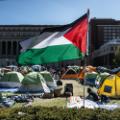
University protests
April 23, 2024 - Israel-Hamas war
By Sana Noor Haq, Christian Edwards, Tori B. Powell and Aditi Sangal, CNN
"There will be nothing left" of Israel if Iran is attacked again, says Iranian president
From CNN's Ruba Alhenawi
An Israeli attack on Iranian territory would have serious consequences and result in there being "nothing left" of Israel, Iran's President Ebrahim Raisi said Tuesday, Iranian state news agency IRNA reported.
"There will be nothing left of that entity" if Israel attacks Iran again, Raisi said.
Raisi's comments were made on the second of his three-day official visit to Pakistan, at a university in Punjab province.
Raisi warned that if Israel "commits another mistake and violates the sovereignty of the holy Iranian lands, the situation will be different."
The warning came after Israel on Friday carried out a military strike inside Iran, a US official told CNN, although Israel has not officially claimed the attack. Officials in Tehran have sought to play down the Friday morning strike on Iran, as tensions simmer from a significant escalation between the regional powerhouses.
IDF warns people to leave "dangerous combat zone" in parts of northern Gaza
From CNN's Lauren Izso and Tim Lister
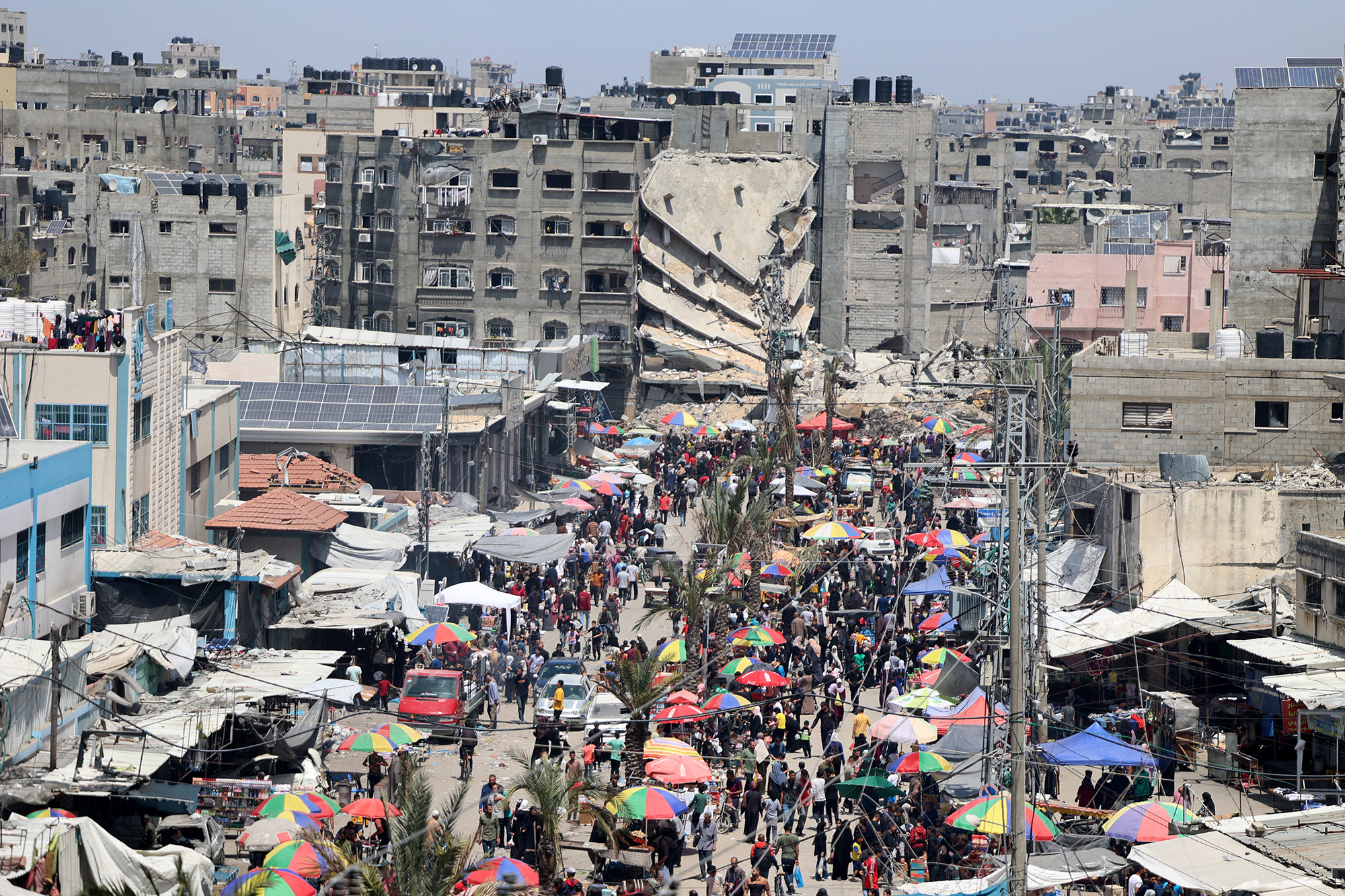
The Israel Defense Forces (IDF) has issued a warning to people in parts of the area of Beit Lahia in northern Gaza.
Identifying several blocks from its map of Gaza, the IDF warns: “You are in a dangerous combat zone. The IDF will work with extreme force against terrorist infrastructure and subversive elements in the region.”
The IDF called on residents to evacuate and "head towards the known shelters in Blocks No. 1770, 1766" in the west and south of the city.
“The most excused is he who warns,” the message ends.
It’s unclear how many people would receive the warning, given the sporadic nature of electricity and connectivity in northern Gaza.
Reports from journalists in Gaza speak of artillery bombardments and air strikes in the north and renewed airstrikes in Zeitoun in central Gaza.
Qatar rules out shutting Hamas office "as long as mediation channels continue"
From CNN’s Mostafa Salem in Abu Dhabi

Qatar is yet to decide whether it will shut Hamas’ office in Doha, Qatar's capital, as it questions both the Palestinian militant group and Israel’s commitment to reach a hostage-ceasefire agreement in Gaza, the foreign ministry spokesperson said on Tuesday.
Qatar has come under pressure from Israel and US politicians over its links with the Palestinian militant group. But it said on Tuesday that there won’t be a need to shut the Hamas political bureau in Doha provided that communication channels remain open.
“If the office is performing that role, as in the mediation efforts are ongoing, then there is no justification to end the presence of the (Hamas) office in Doha,” the spokesperson Majed Al Ansari told a news conference on Tuesday.
“We are calling on both sides to show more flexibility and seriousness in the negotiations,” Ansari said.
Stalled talks: Meetings between negotiators in Qatar have stopped amid a deadlock in the months-long indirect talks between Hamas and Israel. The lack of progress, coupled with criticism of Qatar’s relationship with Hamas, has pushed Doha to reconsider its role as an interlocutor in the stagnant negotiations.
IDF says suspicious aerial targets intercepted off Israel's north coast
From Tamar Michaelis and Charbo Mello
The Israel Defense Forces (IDF) says it has “successfully intercepted two suspicious aerial targets off the northern coast.”
“The sirens regarding rocket fire sounded following the possibility of fallen shrapnel from the interception. The incident has concluded,” it said.
Sirens sounded in the city of Acre for the first time since December.
Hezbollah said that “in response to the Israeli aggression on the town of Adloun and the assassination of one of our mujahideen brothers,” it had launched an attack on the command headquarters of the Golan Brigade and the Eguz 621 unit near Acre.
Earlier, Hezbollah had acknowledged the death of a senior operative, Hussein Ali Azkul. The IDF said it had killed Azkul, whom it described as “a significant terrorist operative in Hezbollah's Aerial Defense Unit” in southern Lebanon .
There are no reports of damage or casualties from the Hezbollah attack.
Hundreds of thousands of tons of waste across Gaza remain uncollected, says UNRWA
From CNN's Tim Lister
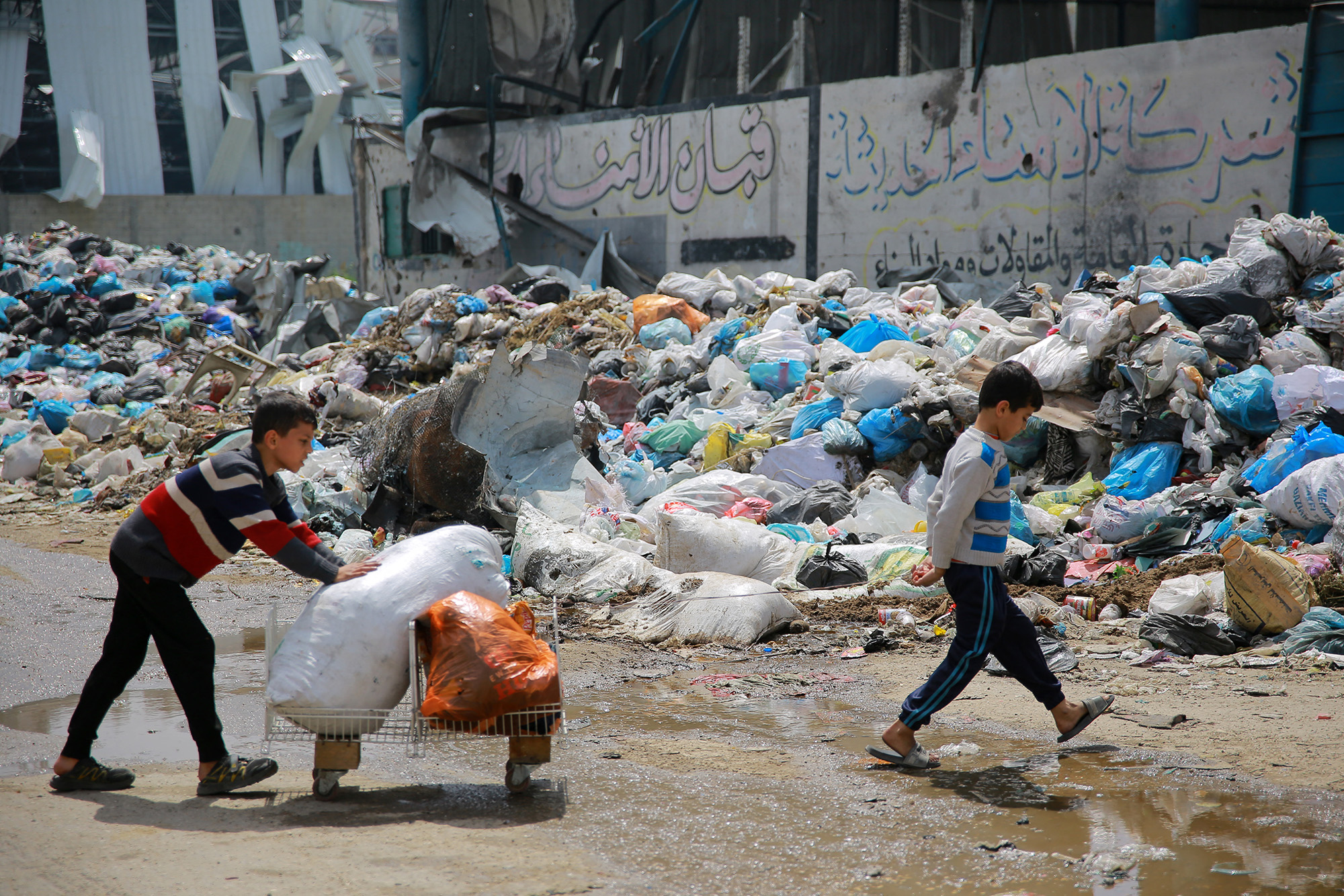
More than 270,000 tons of solid waste across the entire Gaza Strip remain uncollected, the UN's agency for Palestinian refugees (UNRWA) said Tuesday, as Israel's military campaign has disrupted essential services in the enclave. In January and February, UNRWA and the UN's Development Programme collected 10,000 tons of solid waste in Gaza.
Scores displaced: As of April 21, up to 1.7 million people (more than 75% of the entire population) have been displaced across Gaza, the majority multiple times, UNRWA estimated.
Israeli attacks intensified in central Gaza and the southern city of Khan Younis in recent weeks, uprooting "a significant number of displaced people" further south, UNRWA said, adding, “Families are forced to move repeatedly in search of safety." In the northern Gaza and Gaza City governorates, about 300,000 people were estimated to be sheltering.
Relief operations hindered: Efforts to provide relief for Palestinians in northern Gaza have been "severely restricted," the agency said, claiming that Israeli authorities have impeded aid missions to the area.
Israel has longstanding issues with UNRWA, having accused some staffers of being directly involved in the Hamas-led October 7 attacks into southern Israel. An independent review noted that "Israel has yet to provide supporting evidence" for its allegations .
Health system crushed: As of April 17, eight out of 24 UNRWA health centers were operational across the north, central Gaza and in the south, as Israel’s siege in Gaza has diminished food, fuel and water supplies, and severely damaged the medical system.
UN agency claims Israel is impeding aid missions to northern Gaza
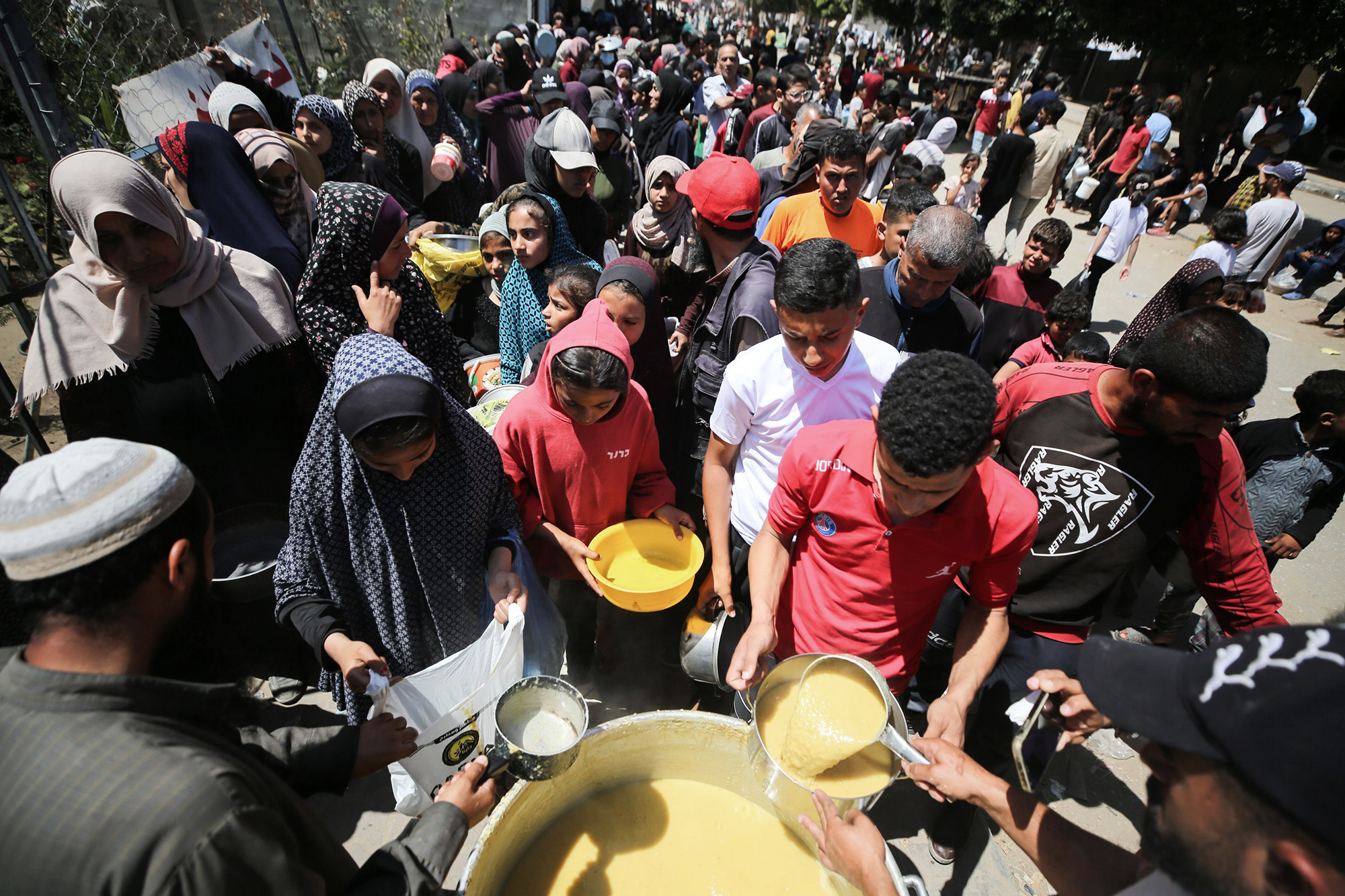
Israel has consistently denied aid convoys to northern Gaza, according to the UN's agency for Palestine refugees (UNRWA). Food shortages are worst in northern Gaza , where Israel concentrated its military offensive in the early days of the war.
Israeli authorities vetoed at least 27 out of 81 aid missions that require coordination in the north and south of the strip, between April 1 and April 19, UNRWA said in a report on Tuesday. The last time UNRWA was able to deliver food supplies to the area was on January 23.
The Israeli agency in charge of inspecting convoys entering Gaza told CNN earlier this month that it was “cooperating [in the north] with a wide array of humanitarian organisations" including UN agencies and regional actors.
Since the beginning of April, an average of 186 aid trucks have crossed into Gaza per day via the Kerem Shalom and Rafah land crossings, UNRWA added. As of 8 April, UNRWA said it had delivered flour to nearly 400,000 families in southern Gaza. Before the war, about 500 trucks of supplies were entering the Palestinian enclave daily.
Barely trickling in: Human rights agencies have repeatedly warned that Israel's severe restrictions on aid entering Gaza means relief is barely tricking into the strip.
UNRWA says there “has been very little significant change in the volume of humanitarian supplies entering Gaza or improved access to the north." Israeli agencies have frequently blamed the United Nations for failing to distribute aid within Gaza, saying last week that hundreds of trucks of aid piled up at Kerem Shalom.
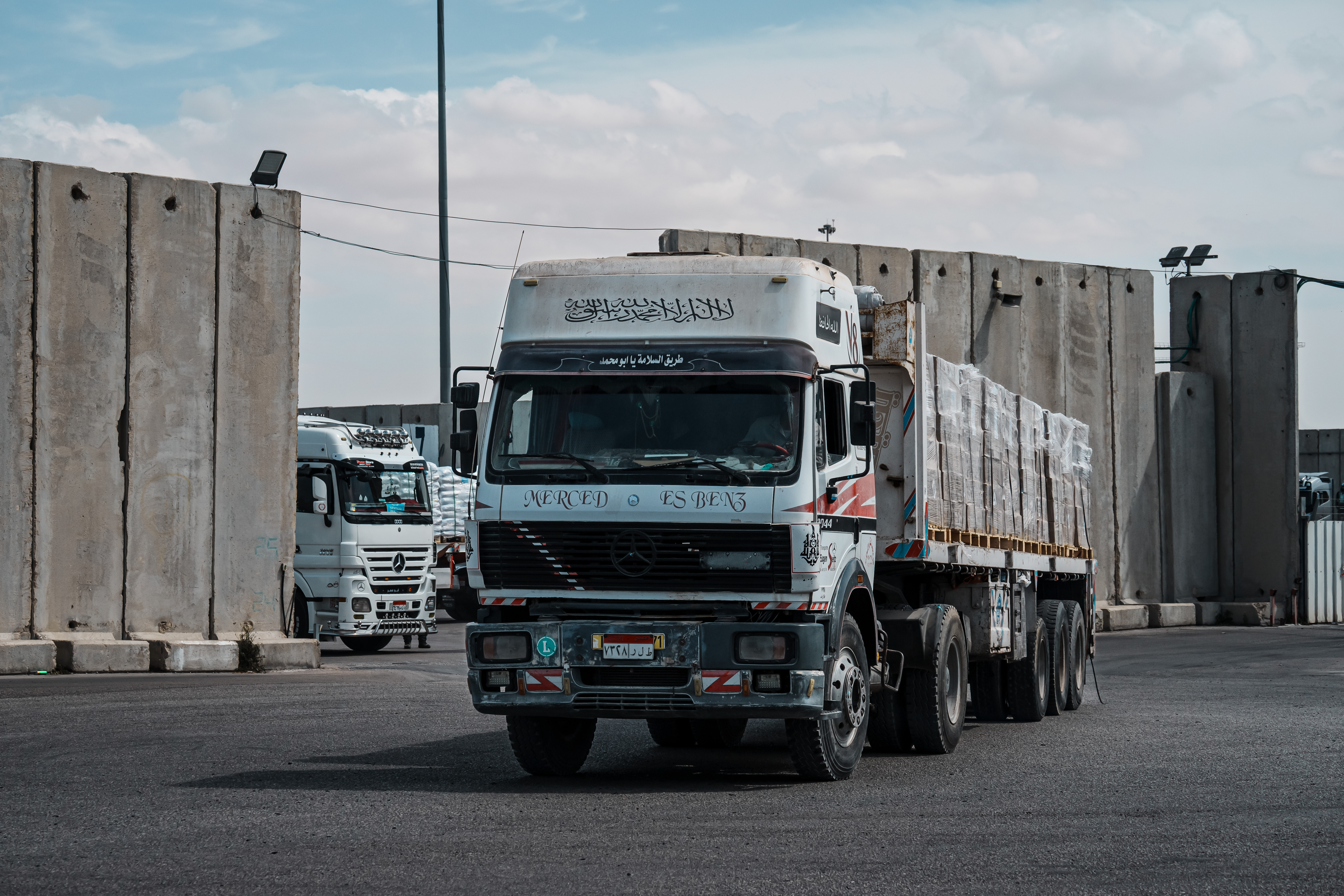
"Destruction like an earthquake." Palestinians return after Israeli forces withdraw from Nuseirat
From CNN’s Mohammad Al Sawalhi, Abeer Salman and Sana Noor Haq
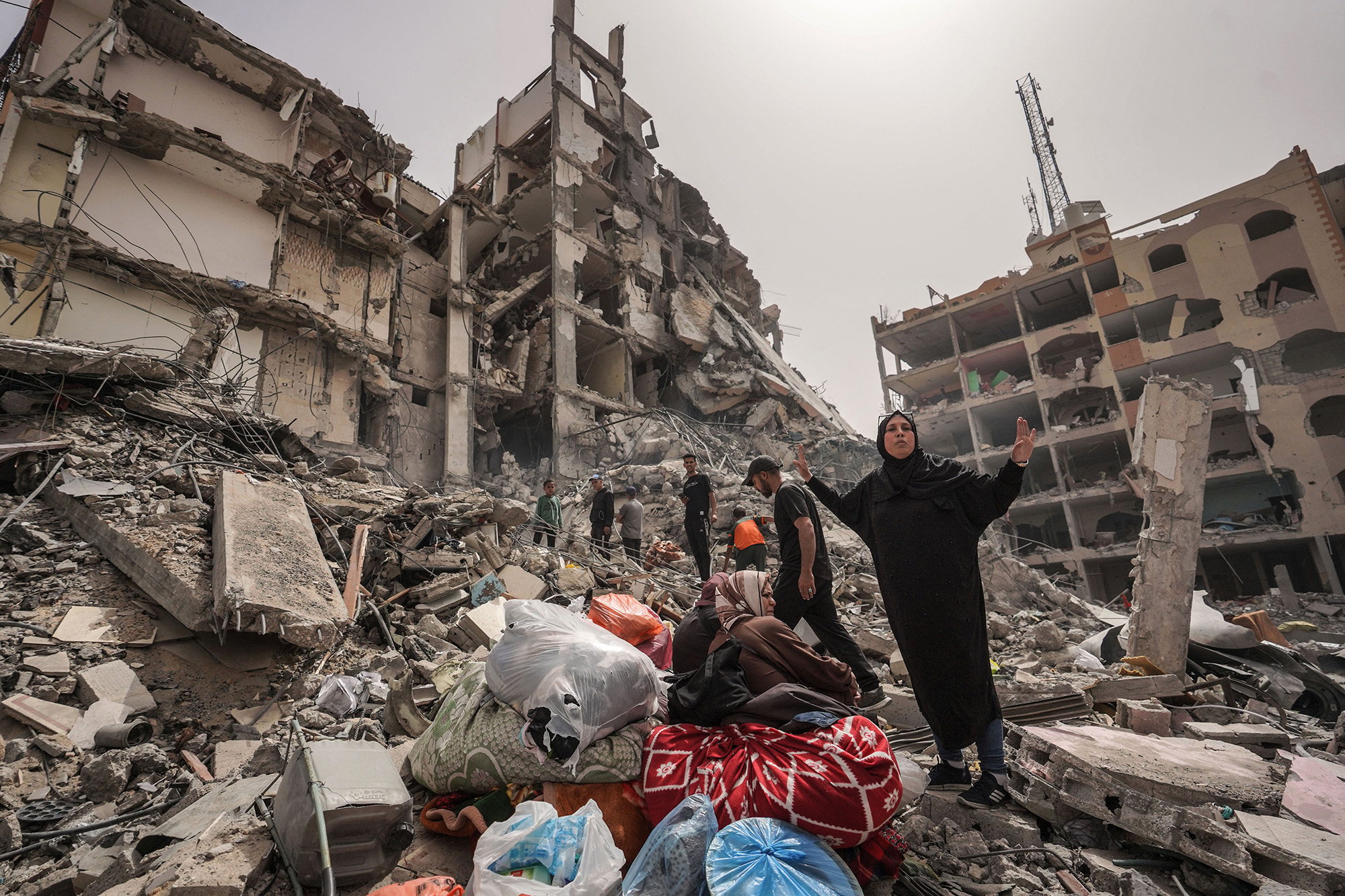
Dozens of Palestinians visited the central Gaza neighborhood of Nuiserat last week, after Israeli forces withdrew.
CNN footage shows the destroyed interior of buildings sliced by bombardment, as men and boys wearing flip flops stand on huge mounds of debris. A young Palestinian child sits on a white sofa surrounded by pink cushions, old blankets, and upturned concrete slabs in the Nuseirat refugee camp. Residents in Gaza say they were desperately trying to salvage precious objects from homes ravaged by Israeli strikes, as they surveyed the area in horror.

“On the second day of Eid rockets started hitting us,” Abu Mohammad Farajallah, a displaced resident, told CNN on April 18. “We came back after a week to struck houses and buildings, there is no place to stay.”
Earlier this month, the Israeli military retreated from Nuseirat and left swathes of rubble, damaged residential buildings and destroyed water, sanitation and waste collection services, Palestinian officials told CNN . Israeli attacks in the neighborhood left at least 500 people killed, injured or missing, said Gaza’s Civil Defense spokesperson, Mahmoud Basal. CNN cannot verify the estimate and contacted the Israeli military about the scope and purpose of its attacks in Nuseirat.
Another resident, Hassan Al Habbash, compared the devastation to “an earthquake.”
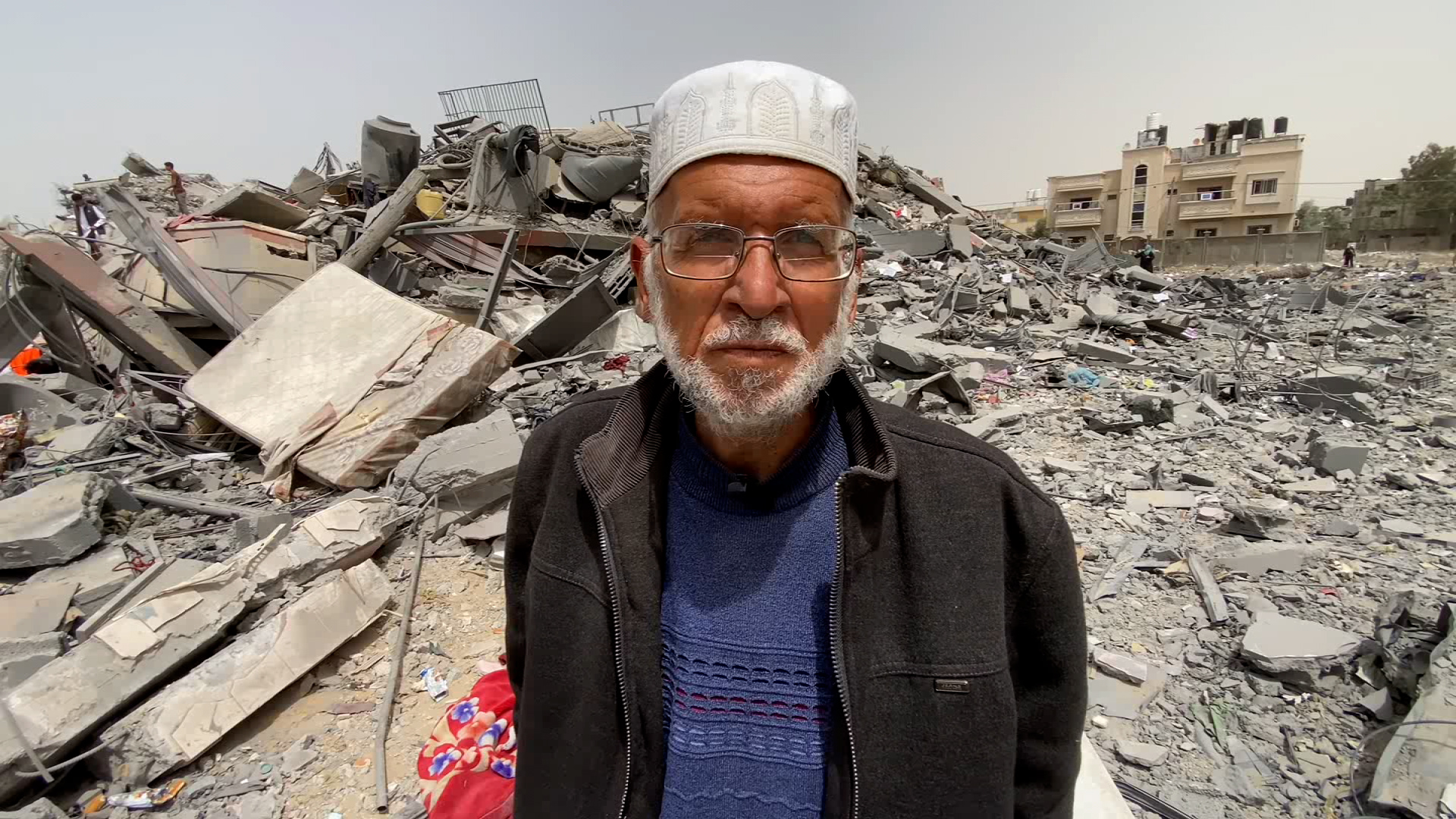
"We have never witnessed such destruction in history,” added the doctor, who wore glasses and had a wispy white beard. “I came back to find my house demolished.”
Israeli air strike destroys top three floors of building in Gaza City, in northern Gaza
From CNN’s Kareem Khadder and Jessie Gretener
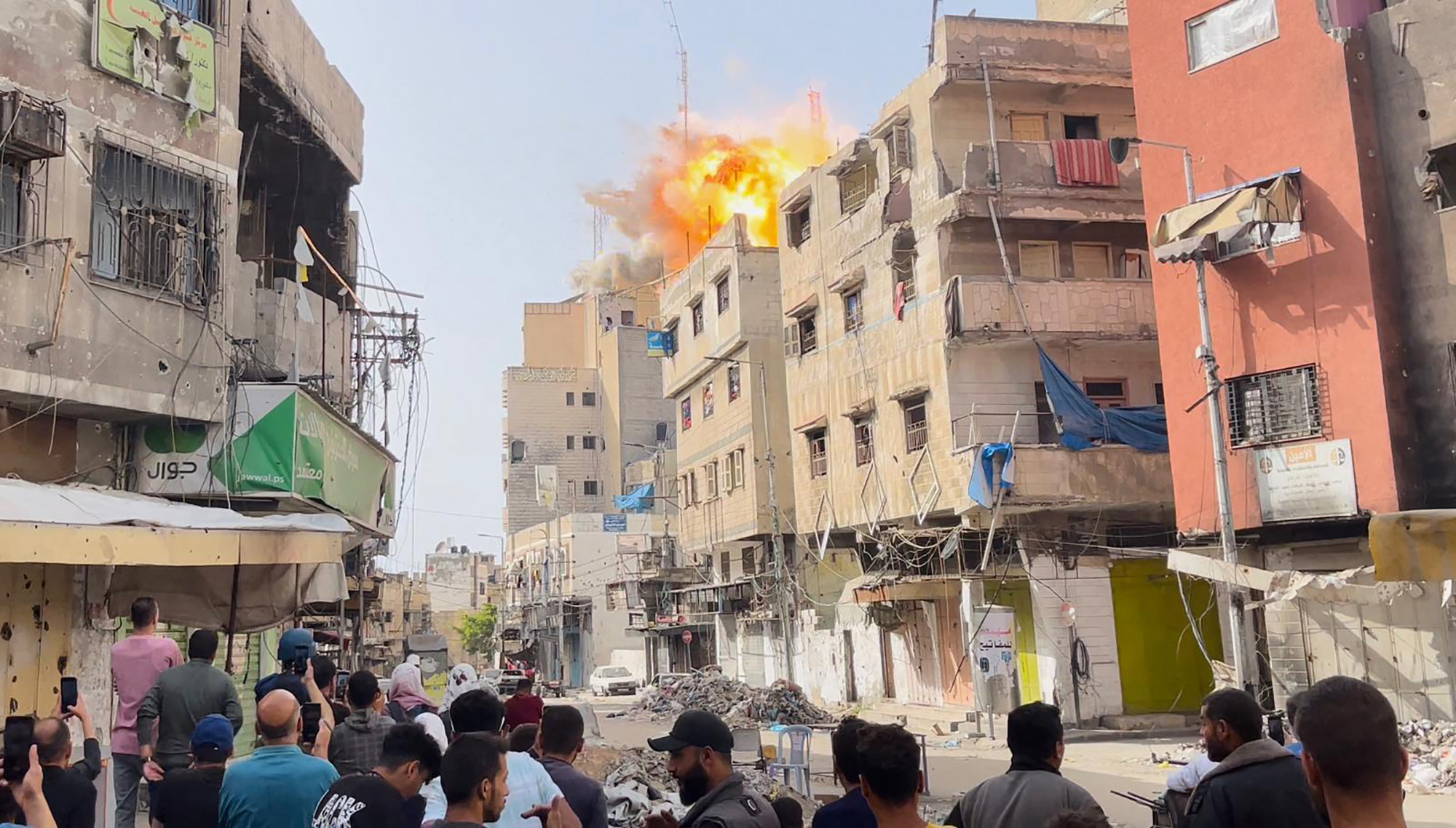
Israel's bombardment demolished the top three floors of the Al-Sahaba building in Gaza City, in the northern part of the enclave, Monday.
Footage from the attack shows the Israeli airstrike hitting the eight-story tower, igniting a ball of fire and triggering a massive plume of smoke. The strike was also captured from a distance, with another video showing a dark cloud of smoke rising on the city’s horizon.
A warning was issued an hour ahead of the strike, with no casualties reported, according to journalists on the ground. The Israeli military says it launched 25 air strikes across Gaza over past 24 hours.
Human rights warnings: Oxfam and Human Rights Watch have accused Israel of imposing "indiscriminate and disproportionate attacks in violation of international humanitarian law" in Gaza.
Israeli military kills two Hezbollah operatives in southern Lebanon
From CNN's Tamar Michaelis and Charbel Mallo
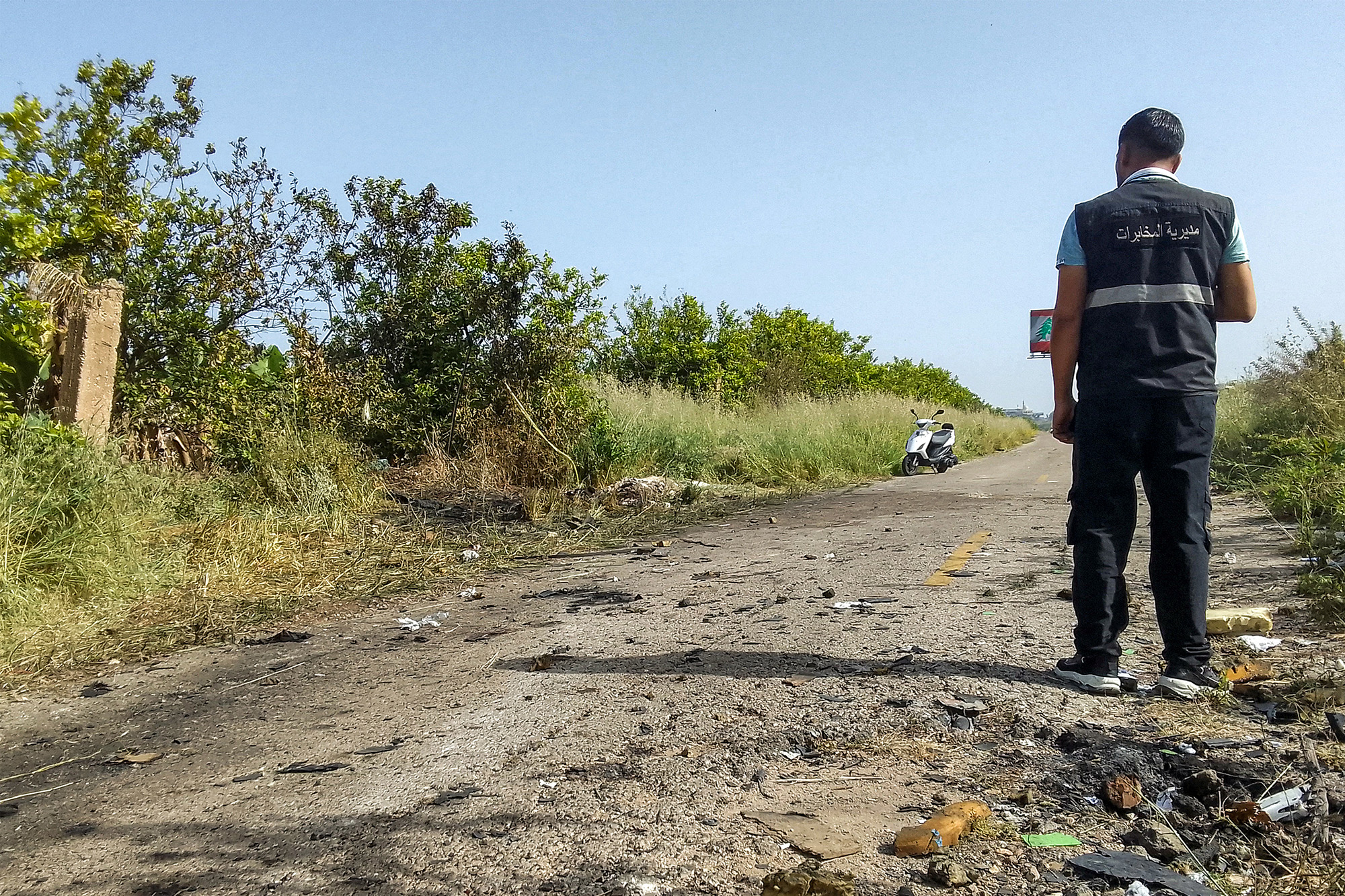
The Israeli military says it killed two members of the Iranian-backed militant group Hezbollah, in southern Lebanon.
The Israel Defense Forces (IDF) struck and killed Hussein Ali Azkul, who it described as “a significant terrorist operative" in Hezbollah's Aerial Defense Unit, in southern Lebanon. Azkul was "heavily involved in the planning and execution of terrorist attacks against Israel," the IDF said in a statement Tuesday.
Hezbollah also acknowledged the death of Azkul in a statement on Tuesday as well, without mentioning the cause or date of death.
The IDF claimed to have killed another “significant terrorist” in Hezbollah’s Aerial Unit -- Sajed Sarafand -- in the area of Arzoun, in southern Lebanon. Sirens were activated Tuesday morning in the western Galilee area, near the Lebanese border, because of a suspected drone infiltration.
Regional tensions: Israeli and Hezbollah forces have engaged in cross-border fire and tit-for-tat exchanges since October 7, when Hamas launched an attack on Israel. Hezbollah’s political stance has unambiguously supported the Palestinian militants. It has roundly condemned Israel’s relentless airstrikes on Gaza.
CNN's Tamara Qiblawi contributed reporting.
Please enable JavaScript for a better experience.
Iran attack: Tehran warns of 'severe' retaliation to any new Israeli attack
What we know.
- The U.S. and its partners will impose new sanctions on Iran , including its missile and drone program, in the "coming days," national security adviser Jake Sullivan said last night as the Biden administration works with allies to contain the fallout from Tehran's retaliatory attack .
- The U.K.'s top diplomat met with Israeli leaders today and said it was "clear the Israelis are making a decision to act." At a military parade in Tehran, Iran's president vowed a "severe and harsh" response to even the "tiniest" new Israeli attack.
- The United Nations appealed for $2.8 billion to provide desperately needed aid to Gaza, where Palestinians face a possible looming famine while the Israeli military continues to carry out deadly strikes.
Qatar undertakes 'comprehensive evaluation' of its role as mediator
Doha Madani
Recent criticisms of Qatar's work as mediator in hostage negotiations has prompted it to conduct a "comprehensive evaluation" of its role, Qatar's prime minister and foreign affairs minister said today.
Sheikh Mohammed bin Abdul Rahman bin Jassim Al Thani told reporters today that the "misuse" of Qatar's mediation for "narrow political interests" forced it to re-evaluate its position.
"There is exploitation and abuse of the Qatari role, and this abuse is unacceptable," Al Thani said. "We started this process from a humanitarian standpoint."
Qatar's embassy yesterday released a statement responding to criticism from Rep. Steny Hoyer, D-Md., who said the U.S. should re-evaluate its relationship to Qatar if it fails to apply pressure on Hamas to agree to a hostage release deal.
The embassy said that it shared Hoyer's frustration but that Qatar began its role as mediator at the request of the U.S. in 2012 and does not control Hamas or Israel. It went on to say that "blaming and threatening is not constructive."
Qatar's prime minister condemns 'policy of collective punishment against the Palestinian people'
It's time for the international community to act, said Qatar's prime minister and head of foreign affairs.
Sheikh Mohammed bin Abdul Rahman bin Jassim Al Thani reiterated his condemnation today of "the policy of collective punishment against the Palestinian people." During a news conference, Al Thani said the current circle of conflicts in the region has a "direct relationship of this to escalation and war on the Gaza Strip."
He urged the international community to work to stop the war in Gaza and "the continuous targeting of the Palestinian people and their killing in this way, as well as the policy of siege and starvation against them and the use of humanitarian aid as a tool for political exploitation."
14 Israeli soldiers wounded in strikes by Hezbollah after IDF killed two commanders
Raf Sanchez
Hezbollah, an Iran-backed group based in Lebanon, injured at least 14 IDF soldiers in strikes on Israel today, a day after two of the group's militia commanders were killed.
The news comes as world leaders urge restraint and express concern that the Israel-Hamas war will spill into a wider regional conflict.
Columbia University president grilled about campus antisemitism at congressional hearing
Emi Tuyetnhi Tran
Columbia University’s president strongly denounced antisemitism during a congressional hearing today, saying that after Hamas’ Oct. 7 attack, “the world changed, and so did my focus.”
“Antisemitism has no place on our campus, and I am personally committed to doing everything I can to confront it directly,” President Nemat “Minouche” Shafik told the Republican-led House Committee on Education and the Workforce. “Israel was brutally attacked by Hamas terrorists, and very soon it became clear that these horrific events would ignite fear and anguish across our campus.”
Shafik faced questions about her handling of antisemitism on campus after the attack alongside two members of Columbia’s board of trustees and the head of its antisemitism task force. She faced particular scrutiny over how the university handled faculty members who made comments about Hamas that were perceived as antisemitic.
Read the full story here.
Netanyahu 'should not be allowed' to drag states into war with Iran, Jordanian minister says
Andrea Mitchell
Netanyahu said Israel will respond to Iran’s retaliatory strikes last weekend as President Joe Biden calls for restraint.
Jordanian Deputy Prime Minister and Foreign Minister Ayman Safadi was critical of Netanyahu, saying he "should not be allowed to drag the U.S. and other Western powers into a war with Iran."
"Jordan will not be a battleground," Safadi said. "We are in the middle of the fire."
Italy would contribute to any U.N. peacekeeping in Gaza
The Associated Press
Italy’s foreign minister says Rome would be willing to contribute troops to any possible U.N. peacekeeping force in Gaza, even though no such proposal is on the table and Israel has rejected the idea.
In an interview with The Associated Press, Foreign Minister Antonio Tajani suggested that a U.N. force under Arab command could help provide security if Israel and Palestinians make headway on an eventual two-state solution. He said the U.N. peacekeeping mission in Lebanon could be the model.
“If there is the solution and for a short time we need the presence of the United Nations under Arab control, we are ready for sending Italian soldiers,” Tajani said ahead of a Group of Seven foreign ministers meeting in Capri.
Netanyahu has ruled out a foreign peacekeeping force in Gaza after the war, saying only Israel is capable of keeping the territory demilitarized.
Gallant vows justice for 14-year-old Israeli boy whose death sparked wave of violence in West Bank
Israeli Defense Minister Yoav Gallant visited the rural area today where 14-year-old Binyamin Ahimeir was found dead, a slaying that ignited a new wave of violence between Palestinians and Israeli settlers in the occupied West Bank.
"We will apprehend the murderers and bring them to justice," Gallant said.
Binyamin was found Saturday, a day after he was reported missing, and the circumstances of his death are under investigation. The Israeli authorities said he was killed in a "terrorist attack" but have not provided additional details.
His death incensed Israeli settlers, sparking violence that resulted in at least two Palestinians' being fatally shot by settlers, as well as numerous injuries. The U.S. State Department condemned the killing of Binyamin and expressed concern about the "violence against Palestinian civilians and their property that ensued."
Netanyahu rejects famine warnings in Gaza
Mithil Aggarwal
Netanyahu rejected warnings of famine in Gaza today, even as the enclave faces a humanitarian crisis with an acute shortage of food and basic supplies.
“Israel goes above and beyond on the humanitarian issue,” Netanyahu’s office quoted him in a statement as saying after he met with British Foreign Secretary David Cameron.
Israel has faced mounting pressure from its allies and aid organizations to increase the flow of supplies to the besieged strip.
More than 4,000 embryos destroyed in strike on Gaza fertility clinic
When an Israeli shell struck Gaza’s largest fertility clinic in December, the explosion blasted the lids off five liquid nitrogen tanks stored in a corner of the embryology unit.
As the ultra-cold liquid evaporated, the temperature inside the tanks rose, destroying more than 4,000 embryos, as well as 1,000 more specimens of sperm and unfertilized eggs, stored at Gaza City’s Al Basma IVF centre.
The embryos were the last hope for hundreds of Palestinian couples facing infertility. At least half of the couples — those who can no longer produce sperm or eggs to make viable embryos — will not have another chance to get pregnant, said Dr. Bahaeldeen Ghalayini, a Cambridge-trained obstetrician and gynecologist who established the clinic in 1997.
“We know deeply what these 5,000 lives, or potential lives, meant for the parents, either for the future or for the past,” Ghalayini said.Asked by Reuters today about the incident, the Israeli military’s media desk said it was looking into the reports. Israel denies intentionally targeting civilian infrastructure, and it has accused Hamas fighters of operating from medical facilities, which Hamas denies.
Three years of fertility treatment were a psychological roller coaster for Seba Jaafarawi. Retrieving eggs from her ovaries was painful, the hormone injections had strong side-effects, and the sadness when two attempted pregnancies failed seemed unbearable.
In September, Jaafarawi became pregnant, her first successful IVF attempt.
“I did not even have time to celebrate the news,” she said.
She had a miscarriage in November, just days after she and her husband were able to leave Gaza for Egypt. Jaafarawi wanted to return to the war zone, retrieve her frozen embryos and attempt IVF again.
But it was soon too late.
10,000 women have been killed in Gaza, U.N. says
Around 10,000 Palestinian women have been killed in Gaza since the war began six months ago, U.N. Women said yesterday in a statement.
Of those, 6,000 were mothers, whose deaths left 19,000 children orphaned, it said, adding the women who have survived "have been displaced, widowed, and facing starvation."
"This devastating differentiated impact continues to make the war on Gaza also a war on women," it said.
Targeting nuclear facilities an option for Israel, former spy chief says
Henry Austin
Targeting nuclear facilities is an option for Israel as it decides how to respond to Iran’s drone and missile attack over the weekend, the former head of the country’s spy agency said today.
“Everything is on the table right now,” Zohar Palti told the British broadcaster Sky News. (Sky News is owned by Comcast, the parent company of NBC News.)
“When and where, we will choose the place,” he added. Asked whether that included targeting nuclear facilities, he said, “including everything.”
Navy ship headed to Gaza had to turn back after engine room fire
Courtney Kube
A U.S. Navy ship on its way to Gaza had to turn back last week after a fire broke out in the engine room, a Navy spokesperson confirmed in a statement to NBC News.
Crew members on the USNS 2nd Lt. John P. Bobo reported the fire Thursday, saying they evacuated the area and used a portable fire extinguisher to smother the flames. No injuries were reported.
The vessel was traveling to the Mediterranean Sea to "deliver equipment and personnel in support of humanitarian aid operations off the Gaza Strip." But it returned to Florida yesterday with just one engine.
The cause of the fire is under investigation.
Israeli military complicit in West Bank settler violence, Human Rights Watch says
The Israeli military either “took part in or did not protect” Palestinians from settler violence in the occupied West Bank, a report by the nongovernmental organization Human Rights Watch published today has found.
HRW said “armed settlers, with the active participation of army units, repeatedly cut off road access and raided Palestinian communities.”
Settlers also “detained, assaulted, and tortured” residents, chasing them out of their homes at gunpoint, it said, based on video analysis and interviews with more than two dozen witnesses.
Gaza death toll nears 34,000, Health Ministry says
At least 33,899 people have been killed in the Gaza Strip since war began, the enclave’s Health Ministry said today in a statement on Telegram.
The ministry said at least 56 people were killed and another 89 people were injured in the last 24 hours during Israeli attacks.
Some of those injured were still trapped under rubble with Israeli forces preventing access for emergency services, it added.
Grief and despair as people seeking refuge in southern Gaza are killed
Peter Jeary
Two separate strikes in the Gaza Strip killed more than a dozen people and left grieving relatives weeping over the dead and injured.
A market crowded with women and children in central Gaza and an apartment in Rafah were struck without warning, eyewitnesses told NBC News' crew in the besieged enclave yesterday.
Gaza cease-fire talks at ‘delicate phase,’ mediator Qatar says
Talks for a new cease-fire and hostage release in Gaza are at a “delicate phase,” Qatar said today, after a senior Arab diplomat with direct knowledge of the negotiations told NBC News that the talks are “almost frozen.”
“We are trying as much as possible to address this stumbling block,” the Gulf state’s Prime Minister and Foreign Minister Sheikh Mohammed bin Abdulrahman Al Thani told reporters in Doha.
“We are trying as much as possible to address this stumbling block and to move forward to put an end to this suffering,” he said.
Qatar has acted as a mediator between Israel and Hamas, brokering talks alongside the U.S. and Egypt.
'We will make our own decisions,' Netanyahu tells allies
Yarden Segev
TEL AVIV — Prime Minister Benjamin Netanyahu has thanked Israel's allies for support in the wake of Iran's retaliatory attack but made it clear that the country will do what it deems necessary to defend itself.
Speaking after meetings with the foreign ministers of Britain and France, Netanyahu said he wanted to "thank our friends for their support for the defense of Israel."
He added that "they also have all kinds of suggestions and advice, I appreciate it, but I want to make it clear - we will make our own decisions, and the state of Israel will do everything necessary to defend itself."
Netanyahu was speaking before a government meeting. In a readout of his discussions with the European diplomats, his office said he also "insisted that Israel preserve the right to self-defense."
Columbia University president to testify in Congress on campus antisemitism, conflicts over Gaza war
It's Columbia University's turn to be grilled before Congress after previous hearings led to the resignations of two Ivy League presidents over questions of antisemitism and the school’s response to conflicts on campus.
Nemat Shafik was originally scheduled to testify in December before the House Education and Workforce Committee, but cited scheduling conflicts at the time.
Tensions and accusations of hate and bias have roiled Columbia, too. In an op-ed published in The Wall Street Journal Tuesday, Shafik emphasized the delicate balance between protecting free speech and fostering a safe environment for students on campus.
“Calling for the genocide of a people — whether they are Israelis or Palestinians, Jews, Muslims or anyone else — has no place in a university community,” Shafik wrote. “Such words are outside the bounds of legitimate debate and unimaginably harmful.”
Iran warns any Israeli attack would bring 'severe and harsh response'
Richard Engel NBC News Chief Foreign Correspondent, Host of MSNBC's "On Assignment with Richard Engel"
TEL AVIV — As Israel weighs its response to the barrage of missiles and drones fired at the country over the weekend, Iran’s president could not have been more clear with his messaging: Don’t attack.
Speaking at an army parade this morning in Tehran, Ebrahim Raisi said that even the “tiniest” attack by Israel would bring a “severe and harsh response.”
It comes as the Israeli military is promising to respond to Iran’s weekend barrage of missiles and drones.
“Firing 110 ballistic missiles directly to Israel will not get scot-free. We will respond in our time, in our place, in the way that we will choose,” IDF spokesperson Rear Adm. Daniel Hagari said.
Direct hit on building in northern Israel injures 13
At least 13 people were injured after rockets struck western Galilee in northern Israel today, the country's emergency services said in a statement.
The Magen David Adom emergency responders, along with the IDF, are providing medical treatment to the injured and evacuating them to the medical center in Nahariya, it said.
Four of the injured are in serious condition, it added.
In recent days, there have been frequent exchanges across the border with Lebanon between the Israeli military and the Iran-backed Hezbollah militant group.
Hezbollah said in a statement that it had struck a building in the village of Arab Al-Aramshe, in the western Galilee, this morning. It claimed to have killed and wounded Israeli soldiers in the attack, which it said was a response to the Israeli killing of its members and commanders in Lebanon.
NBC News has not independently verified the claims.
Israel analyzes debris from Iranian missiles that were shot down
CENTRAL ISRAEL — While the vast majority of Iran’s ballistic missiles were intercepted outside Israeli airspace, the country's military now faces the task of collecting and analyzing those that did get through.
NBC News was given access to a military base in central Israel yesterday, where we saw what the Israel Defense Forces said was the remains of a fuel tank from one of those ballistic missiles.
A hulking tube 36 feet long, it would have carried a warhead that weighs around a thousand pounds, said Rear Adm. Daniel Hagari, the IDF's chief spokesperson. “If those ballistic missiles would have hit Israel, it would have caused dangerous consequences to the region,” he told reporters.

The IDF said the fuel tank may have been from an Emad missile but that it continued to study the weapon. The fuel tank was found in the Dead Sea and the IDF believes it fell there after being intercepted. A rip in its metal side pointed to possible shrapnel from an interception.
Four ballistic missiles did make it through Israeli air defenses and slammed into Nevatim air base in the south of the country. The IDF said they caused minimal damage and the base remained operational at all times.
Pressed by NBC News, Hagari would not say whether Israel was committed to launching airstrikes or whether it would consider cyberattacks or other covert means to respond to Iran. “We will respond at our time at our way the way we choose to do,” he said.
Ukraine sees allies help protect Israel from Iran attack and asks: What about us?
Daryna Mayer
KYIV, Ukraine — In the wave of Iranian drones and missiles that were shot down before reaching their targets over the weekend, another ally sees the possibilities, and limits, of Western support.
The United States and its partners helped Israel, so why — Ukraine is asking — won’t they help protect us from Russian attacks?
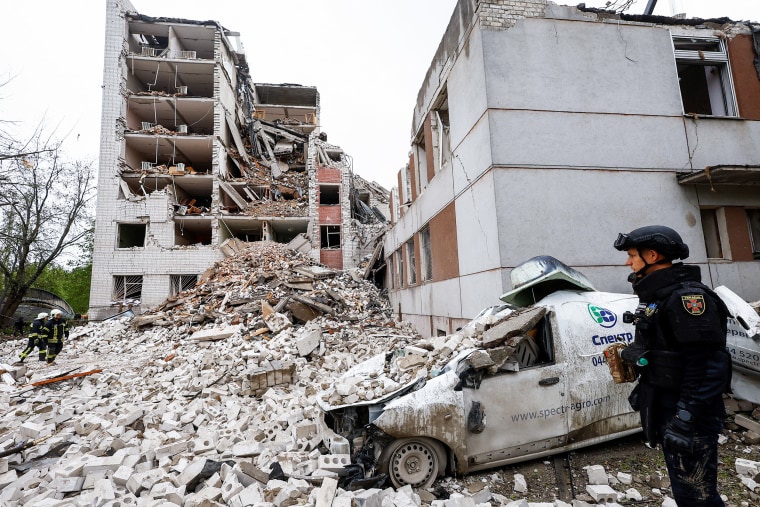
It “looks extremely strange,” Ukrainian presidential adviser Mykhailo Podolyak told NBC News in an interview yesterday.
“How does the civilian population of Ukraine or the civilian infrastructure of Ukraine differ from the civilian population of Israel from a humanistic point of view?” he asked bluntly.
'The Israelis are making a decision to act'
Israel has made a decision to respond to Iran's retaliatory strikes, British Foreign Secretary David Cameron said after meeting the Israeli President Isaac Herzog this morning.
"It’s clear the Israelis are making a decision to act," he told reporters. "We hope they do so in a way that does as little to escalate this as possible."
Cameron said Israel should refocus on its war against Hamas and on the release of the hostages. Tehran has said that any retaliation by Israel will not go unpunished.
Herzog also met with German Foreign Minister in Jerusalem Annalena Baerbock and thanked the two for the "warm discussion."
Iran hails success of retaliatory attack during military parade
Iranian President Ebrahim Raisi has hailed what he framed as the success of the country's retaliatory strikes on Israel, speaking at an annual military parade in Tehran today.
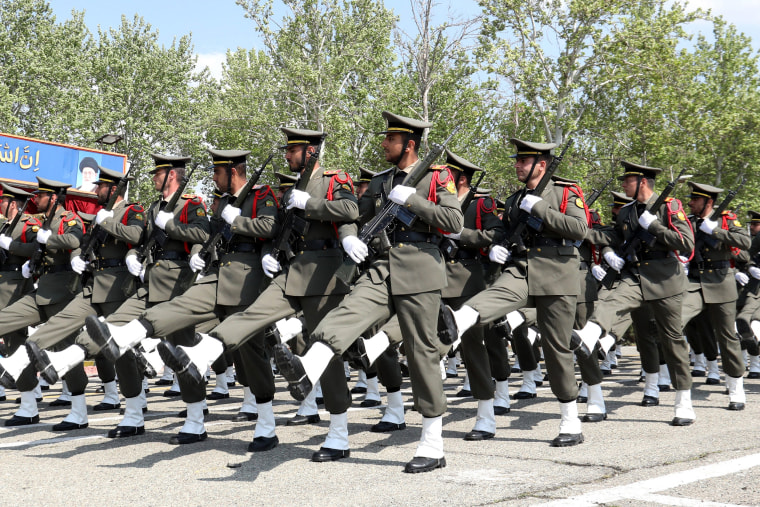
Raisi said that the operation was "limited" and "punitive" but that any Israeli response would be met with a retaliation that would not be limited.
“The army stands by the nation and acts to defend the homeland, territorial integrity, and the values of the Islamic Revolution,” he said, according to the state news agency IRNA.
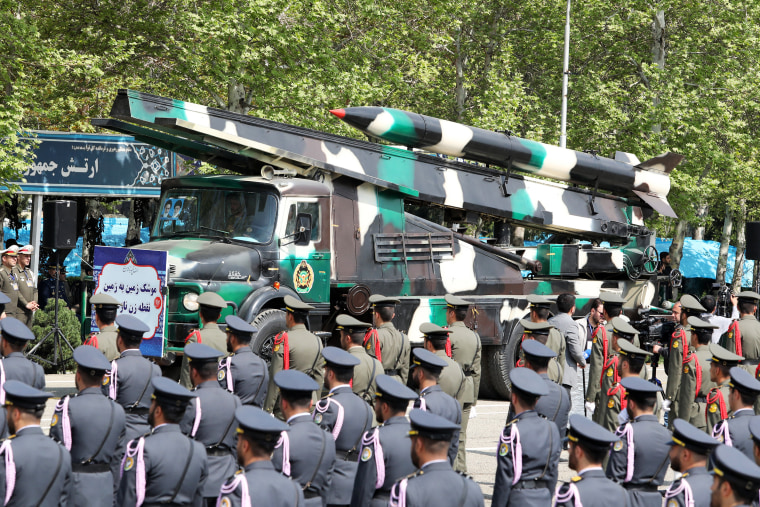
U.N. appeals for $2.8 billion to provide aid to Palestinians
The United Nations appealed for $2.8 billion yesterday to provide desperately needed aid to 3 million Palestinians. It stressed that tackling a looming famine in Gaza requires not only food, but also sanitation, water and health facilities.
Andrea De Domenico, head of the U.N. humanitarian office for Gaza and the West Bank, told reporters that “massive operations” are required to restore those services and meet minimum standards — and this cannot be done during military operations.
He pointed to the destruction of hospitals, water and sanitation facilities, homes, roads and schools, adding that “there is not a single university that is standing in Gaza”.
De Domenico said Israel’s recently-ended second major military operation at Al-Shifa Hospital, Gaza’s largest medical facility, was so destructive that it has been forced to shut down.
Iranian propaganda aims missiles at Israel
Max Butterworth
A huge banner displayed across the facade of a building in the Iranian capital, Tehran, yesterday depicts missiles aimed at Israel.
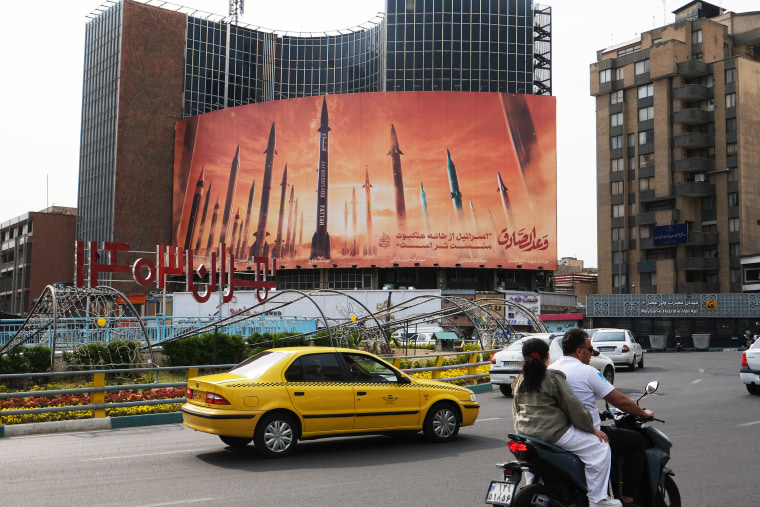
U.S. will impose new sanctions on Iran, strengthen missile defense in Middle East
Monica Alba
Phil Helsel
The United States will put in place new sanctions targeting Iran and entities that support its Islamic Revolutionary Guard “in the coming days,” national security adviser Jake Sullivan said last night.
Sullivan said that the U.S. military will also work to strengthen missile defense and early warning systems across the Middle East “to further erode the effectiveness of Iran’s missile and UAV capabilities.”
“These new sanctions and other measures will continue a steady drumbeat of pressure to contain and degrade Iran’s military capacity and effectiveness and confront the full range of its problematic behaviors,” Sullivan said in a statement.
The European Union’s top diplomat Josep Borrell said its foreign affairs council met and was also united in increasing its sanctions against Iran.
Gaza cease-fire talks ‘almost frozen,’ Arab diplomat says
JERUSALEM — At the moment, talks for a cease-fire and the release of Israeli hostages by Hamas are “almost frozen,” a senior Arab diplomat with direct knowledge of the negotiations told NBC News.
The official did not attribute blame and said discussions stalled as tensions with Iran took center stage following Israel’s April 1 attack on the Iranian embassy compound in Damascus.
Prime Minister Benjamin Netanyahu’s office said on Sunday that Hamas had rejected Israel’s most recent offer for a deal.
Catch up on our latest coverage
- An uneasy alliance of Arab states helped defend Israel from Iran. Their resolve may soon be tested.
- Sen. Tom Cotton doubles down on comments urging people to ‘forcibly remove’ protesters blocking traffic
- Artist refuses to open Israeli pavilion at Venice Biennale until Gaza cease-fire, hostage release
- Mike Johnson unveils plan to move Israel, Ukraine and Taiwan aid as separate bills this week
- U.S. officials expect Israeli response to Iran strikes will be limited

IMAGES
COMMENTS
The Footsteps of Jesus in the Galilee. Step into the ancient footsteps of Jesus in the Galilee. It is a journey that begins in Nazareth and takes in the sites of miracles on the Sea of Galilee. A region of orchards, wildflower meadows and mountain panoramas in northern Israel, the natural beauty of the Galilee cannot be overstated.
A 65-kilometer Jesus Trail starts in Nazareth and goes through Tzipori National Park, Cana, the Horns of Hattin, Mount Arbel, Capernaum, Tabgha, and the Mount of Beatitudes, connecting the major pilgrimage sites in Galilee. If you're visiting Israel on a budget, hiking is one of the best ways to do so. Sea of Galilee Trail.
Most of northern Israel is generically known as The Galilee (Galil in Hebrew). It stretches virtually from the Mediterranean to the harp-shaped Sea Of Galilee and River Jordan on whose shores vast history has been made. Here is Mount Gilboa where King Saul and his son, Jonathan, died in battle against the Phillistines. Hazor, according […]
A visit to Israel and the Sea of Galilee is not only a walk through time and religious history, but also a soothing respite to relax on a sandy beach, unwind with a leisurely scenic drive around the lake, or hike or bike the trails and absorb the beautiful scenery encompassing the area.
Sea of Galilee. Israel, Middle East. The shores of the Sea of Galilee (in Hebrew, Yam Kinneret or HaKinneret), by far Israel's largest freshwater lake, are lined with great places to relax: beaches, camping grounds, cycling trails and walking tracks.
Discover the best attractions in Sea of Galilee including Mount of the Beatitudes, Ancient Galilee Boat, and Capernaum. Lonely Planet. Destinations. Planning. Inspiration. Shop. Search. Saves. Open main menu. Middle East. ... Opened in 1993, this lakeside cultural centre - one of Israel's most beautiful buildings - is known for its art ...
The Sea of Galilee, also known as Lake Kinneret, is the largest freshwater lake in Israel and the setting for many biblical events. Visit the Mount of Beatitudes, Tabgha, and Capernaum, where the ruins of an ancient synagogue stand as a testament to the area's historical and spiritual significance. The largest city on the shore of the ...
In the Footsteps of Jesus - Private Tour of Nazareth (half-day) 1. Historical Tours. from. $695. per group (up to 2) Haifa Port Shore Excursion: Nazareth and Sea of Galilee Day Tour from Haifa Port. 18. Historical Tours.
The Sea of Galilee is the enthralling power of this region for Christian visitors, where you don't have to close your eyes to picture Jesus here - you have to open them. As Matthew 4:13 tells us, Jesus went from Nazareth in the heart of Galilee, to Capernaum by the shore of the lake they called Genesaret. Here He gathered His first ...
The site also features "Duc in Altum" a place for worship and prayer. Magdala is known as a crossroads of Jewish and Christian History, and will soon also feature a guesthouse in opening mid-2018. 2. Sea of Galilee. This large fresh water lake has had a central role in history as a reservoir for the entire region. 3.
1. Tiberias Tiberias . Sitting on the edge of the Sea of Galilee, Tiberias is the perfect base to explore this region. The waterside street, Yigal Alon Promenade, is home to most of the town's tourist attractions and is a great place for a lakeside stroll.Along this road, you'll find the 19th-century Church of St. Peter, built over the remains of a Crusader castle.
Places to visit in the Galilee Tel Megiddo (Mount Megiddo) tel: 04-659 0316. On Highway 66, 2km (1.3 miles) to the north from Megiddo Junction. In the center of the Jezreel (Izre'el) Valley, in the heap of ruins that make up the tel (mound) of Megiddo, archeologists have uncovered 20 cities.At the visitors' center a miniature model of the site gives definition to what the untrained eye ...
Galilee Travel Guide. The Galilee, a popular tourist region for Christian tours to the Holy land is a mountainous, fertile region in northern Israel. It's known for the Sea of Galilee, where Jesus began His ministry and is said to have walked on water. The city of Tiberias is on the shores of the Sea of Galiee, also known as lake Kinneret, and ...
Although Galilee is considered a year-round destination, April or May or between September and November are the best times to visit as you'll avoid the heat and humidity of the summer months. Winters are cool and can be wet, but are often the most tranquil time to visit rural Israel. Temperature. Rainfall. Daylight.
The Western Galilee is a modern Israeli term, which in its minimal definition refers to the coastal plain just west of the Upper Galilee, also known as Plain of Asher or Plain of the Galilee, which stretches from north of Acre to Rosh HaNikra on the Israel-Lebanon border, and in the common broad definition adds the western part of Upper Galilee ...
Best time to visit Galilee. Although Galilee is considered a year-round destination, April or May or between September and November are the best times to visit as you'll avoid the heat and humidity of the summer months. Winters are cool and can be wet, but are often the most tranquil time to visit rural Israel. Temperature.
Along the coast, tourists love hanging out on the Galilee's hot sandy beaches or visit the eerie glowing beauty of the Rosh Hanikra grottoes. ... Israel Highlights Tour - All Year Low Season Rate deal for tours to Israel. book now. Trips Israel LLC. $1,295. Christian Holy Land Tours from $1,295.
When the Israelites took possession of Palestine, the Canaanites were strongly entrenched in Galilee. The Book of Judges (1:30-33) suggests that even after Joshua's conquest, Jews and Canaanites lived together there. During the reigns of David and Solomon (10th century bce), Galilee was part of their expanded kingdom; subsequently, it came under the northern kingdom of Israel.
Sea of Galilee Facts. The lake is approximately 8 miles across and, in total, is about 64 square miles in size. It sits around 700 feet below sea level. To the east of it lie the borders of modern-day Syria and Jordan. To its west is the region of the Galilee, which includes several cities you might recognize.
Here are some of Israel's 300+ vineyards producing award winning wines. And here are pretty villages, towns and cities including Nazareth and Carmiel. In addition to hotels and very comfortable kibbutz guest houses, the Galilee is filled with dozens of country bed-and-breakfast accommodations, known as zimmerim.
The man was named as Sharif Suad from the Bedouin town of Sallama, located in the Galilee in northern Israel. Suad was a military contractor conducting "infrastructure activity" when he was struck.
04/25/2024 03:36 PM Hamas official: 'Israel plans to occupy 20% of the Gaza Strip' By JERUSALEM POST STAFF 04/25/2024 03:28 PM Iraq hangs 11 convicted of terrorism in latest mass executions
Visionaries will see the new wine route at the Golan, reopening the Mahanayim Airport for easier commute, international music festivals with sunrise tours to the Sea of Galilee. When more visitors ...
The newspaper cites Israeli media reports about the hardships experienced by the residents of northern Israel, the extent of the displacement and statements of heads of Galilee local councils accusing the government of abandoning them. The idea is to show readers that the pressure on Lebanon is designed solely to serve Israeli interests.
An Israeli attack on Iranian territory would have serious consequences and result in there being "nothing left" of Israel, Iran's President Ebrahim Raisi said Tuesday, Iranian state news agency ...
U.S. will impose new sanctions on Iran. Israel promises to respond to Iran's attack. United Nations asks for Gaza aid as famine looms. IDF carries out deadly Gaza strikes
10:43 p.m. ET, April 12, 2024 USAID worker killed in Israel, agency says. From CNN's Jennifer Hansler